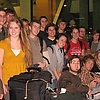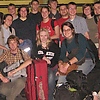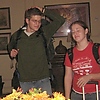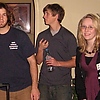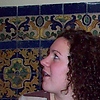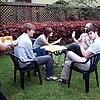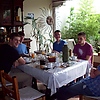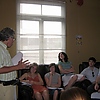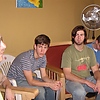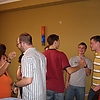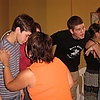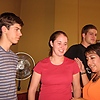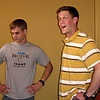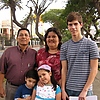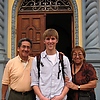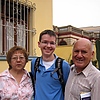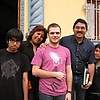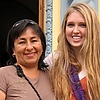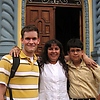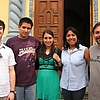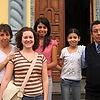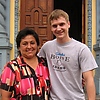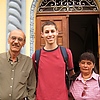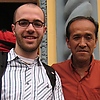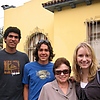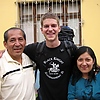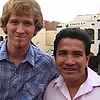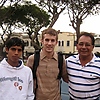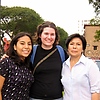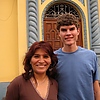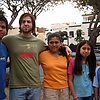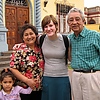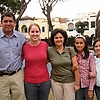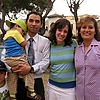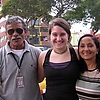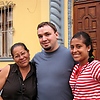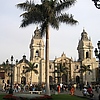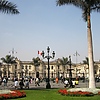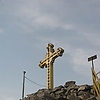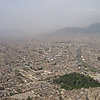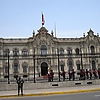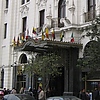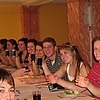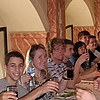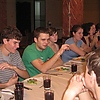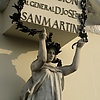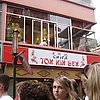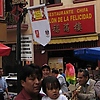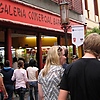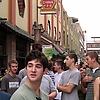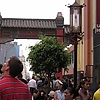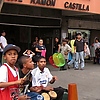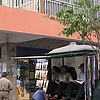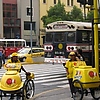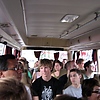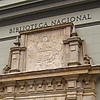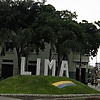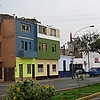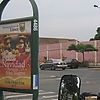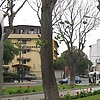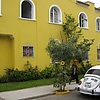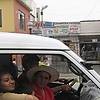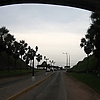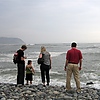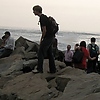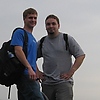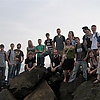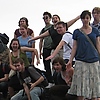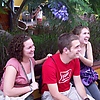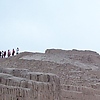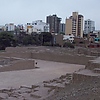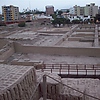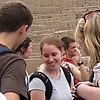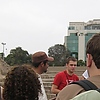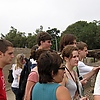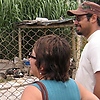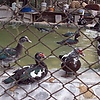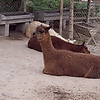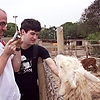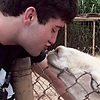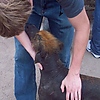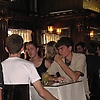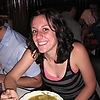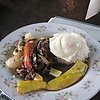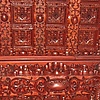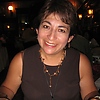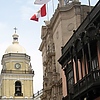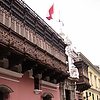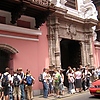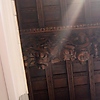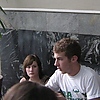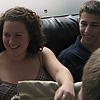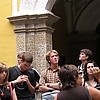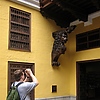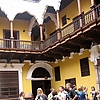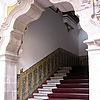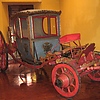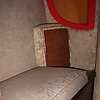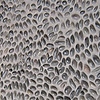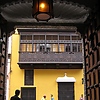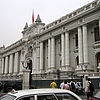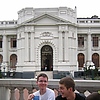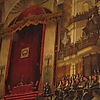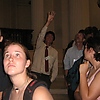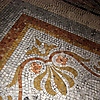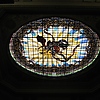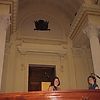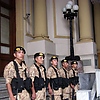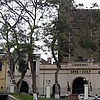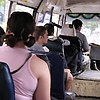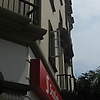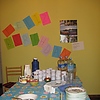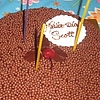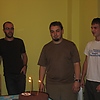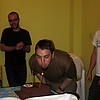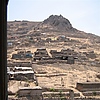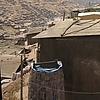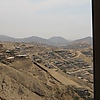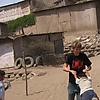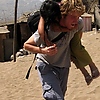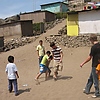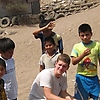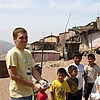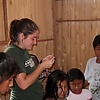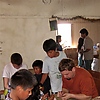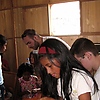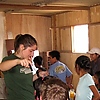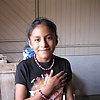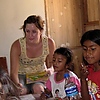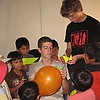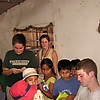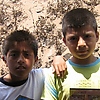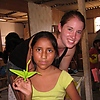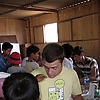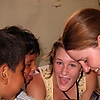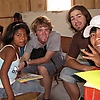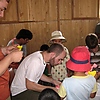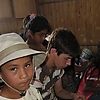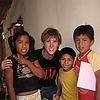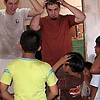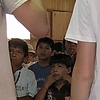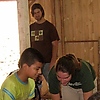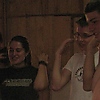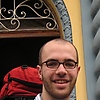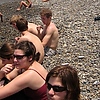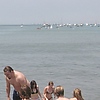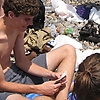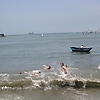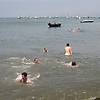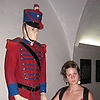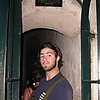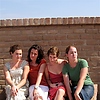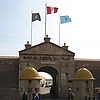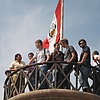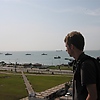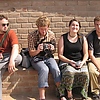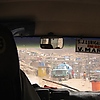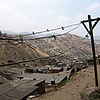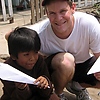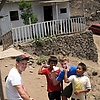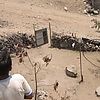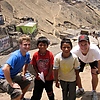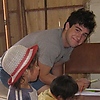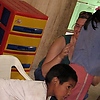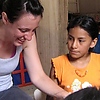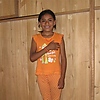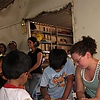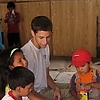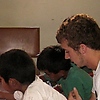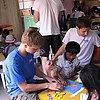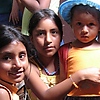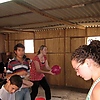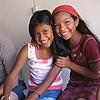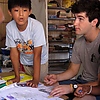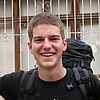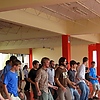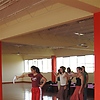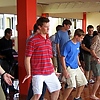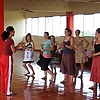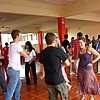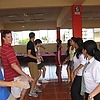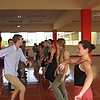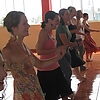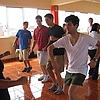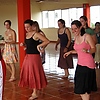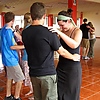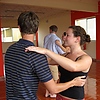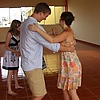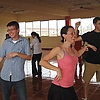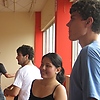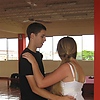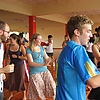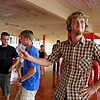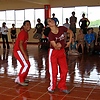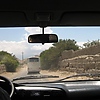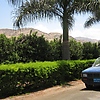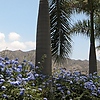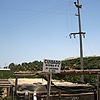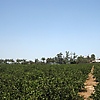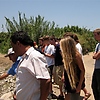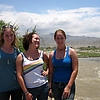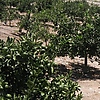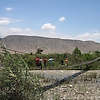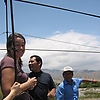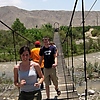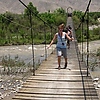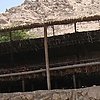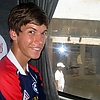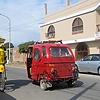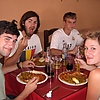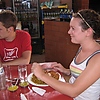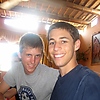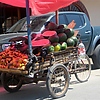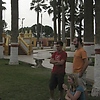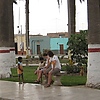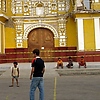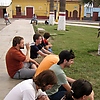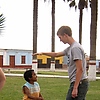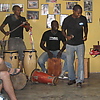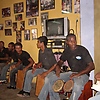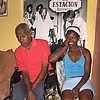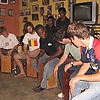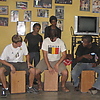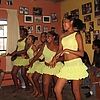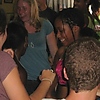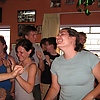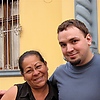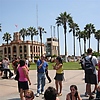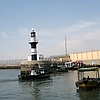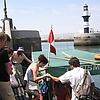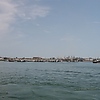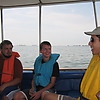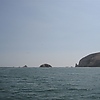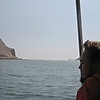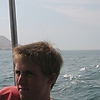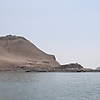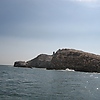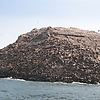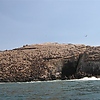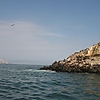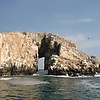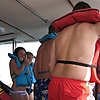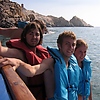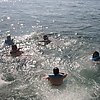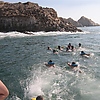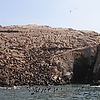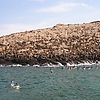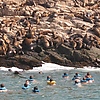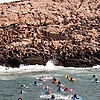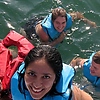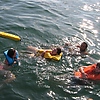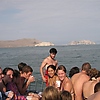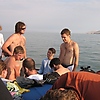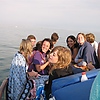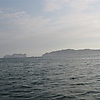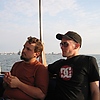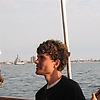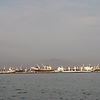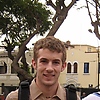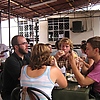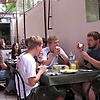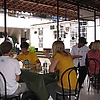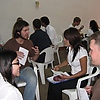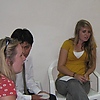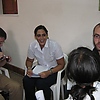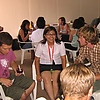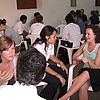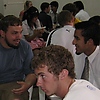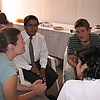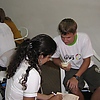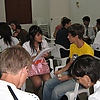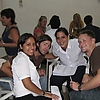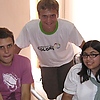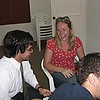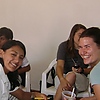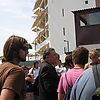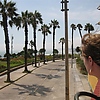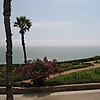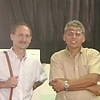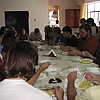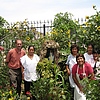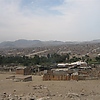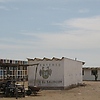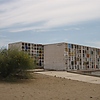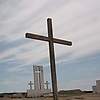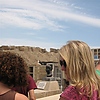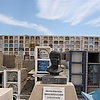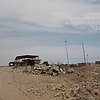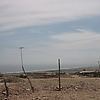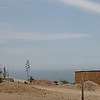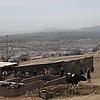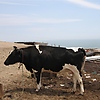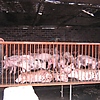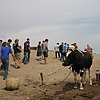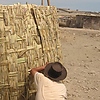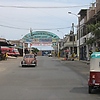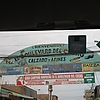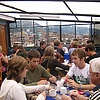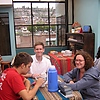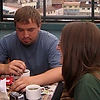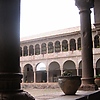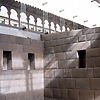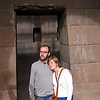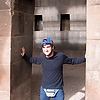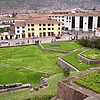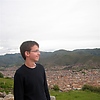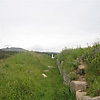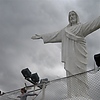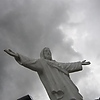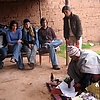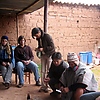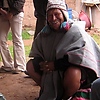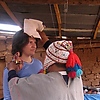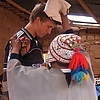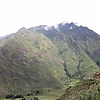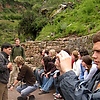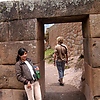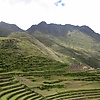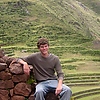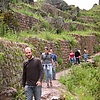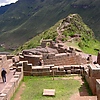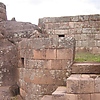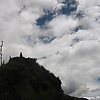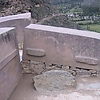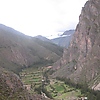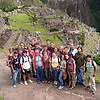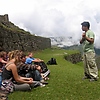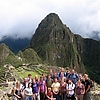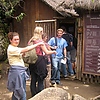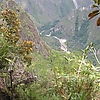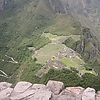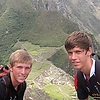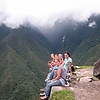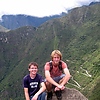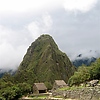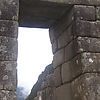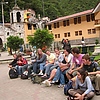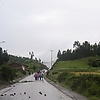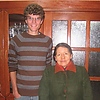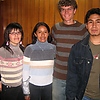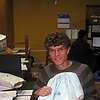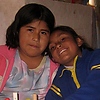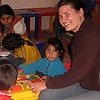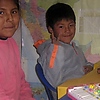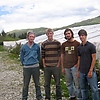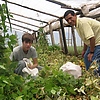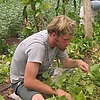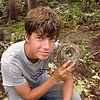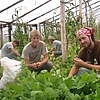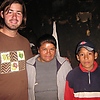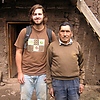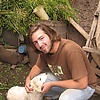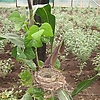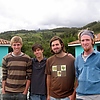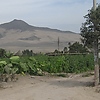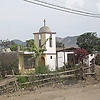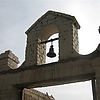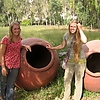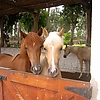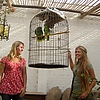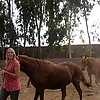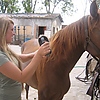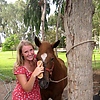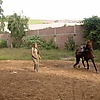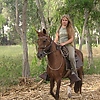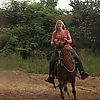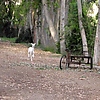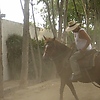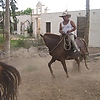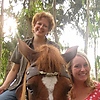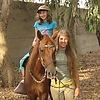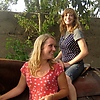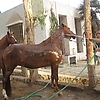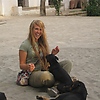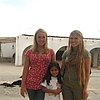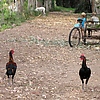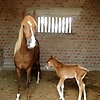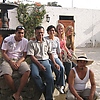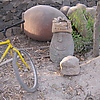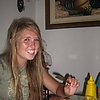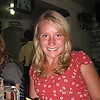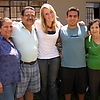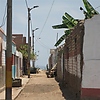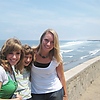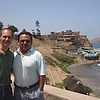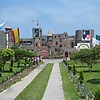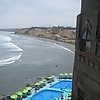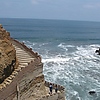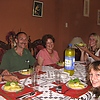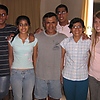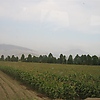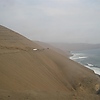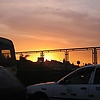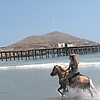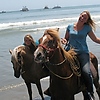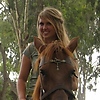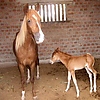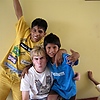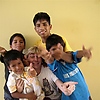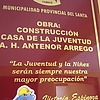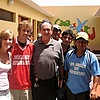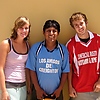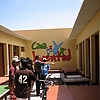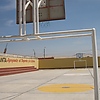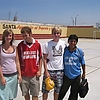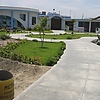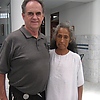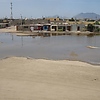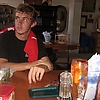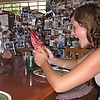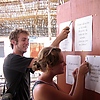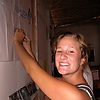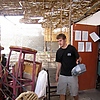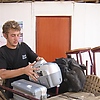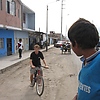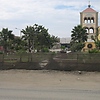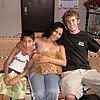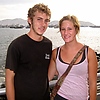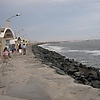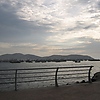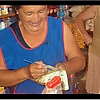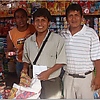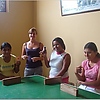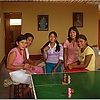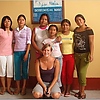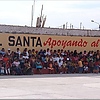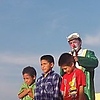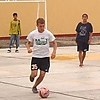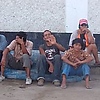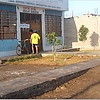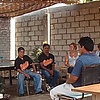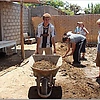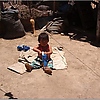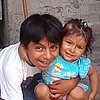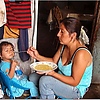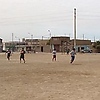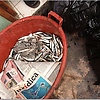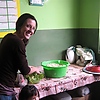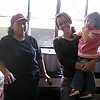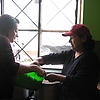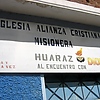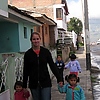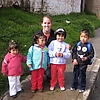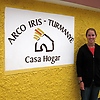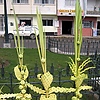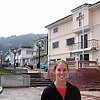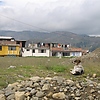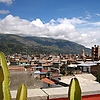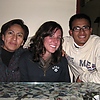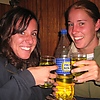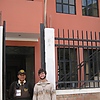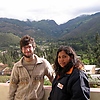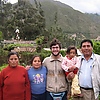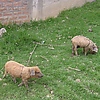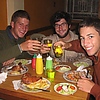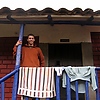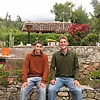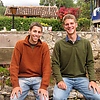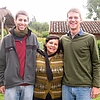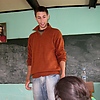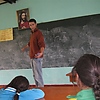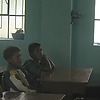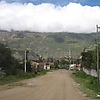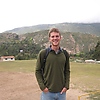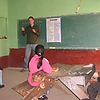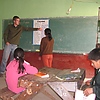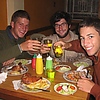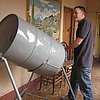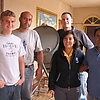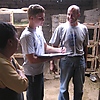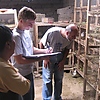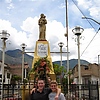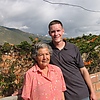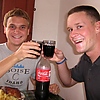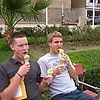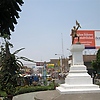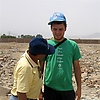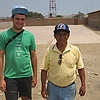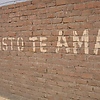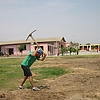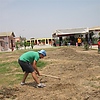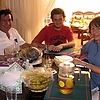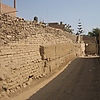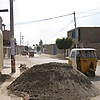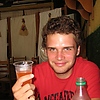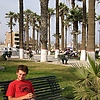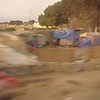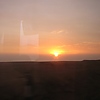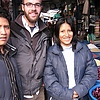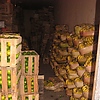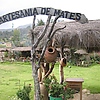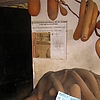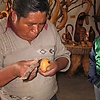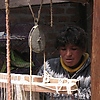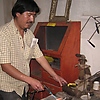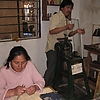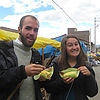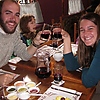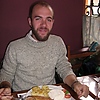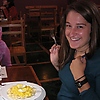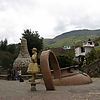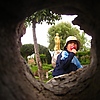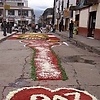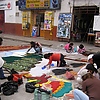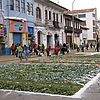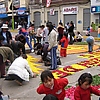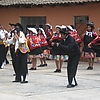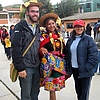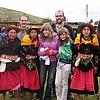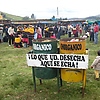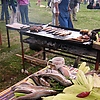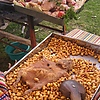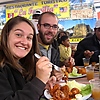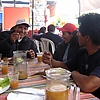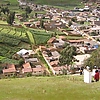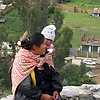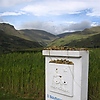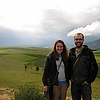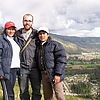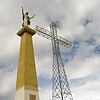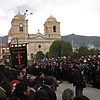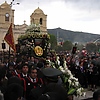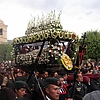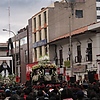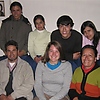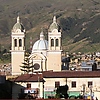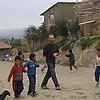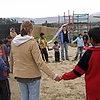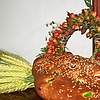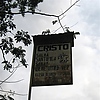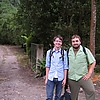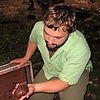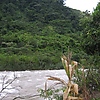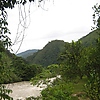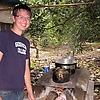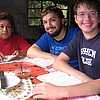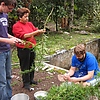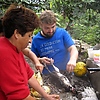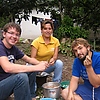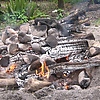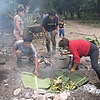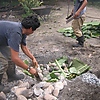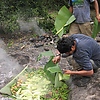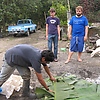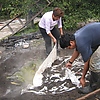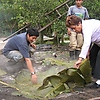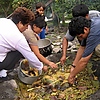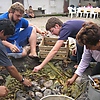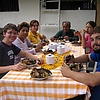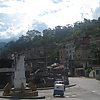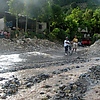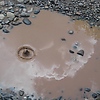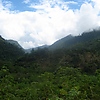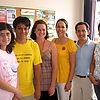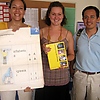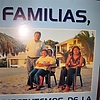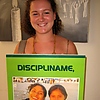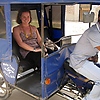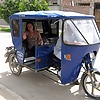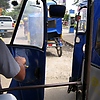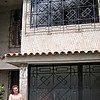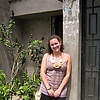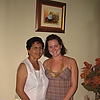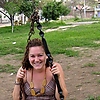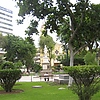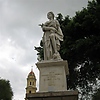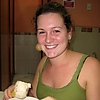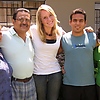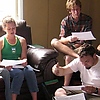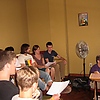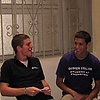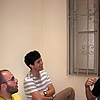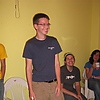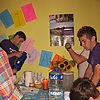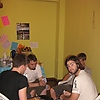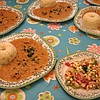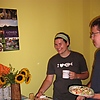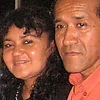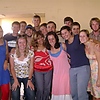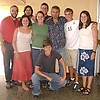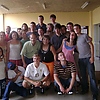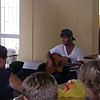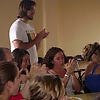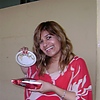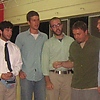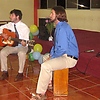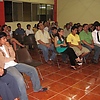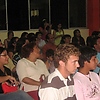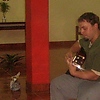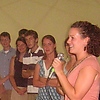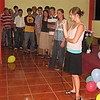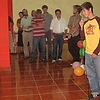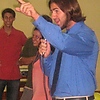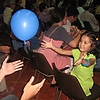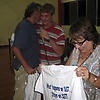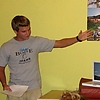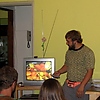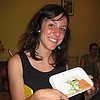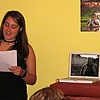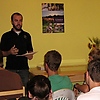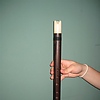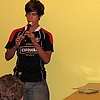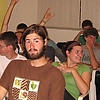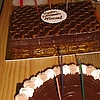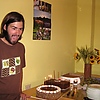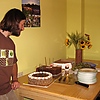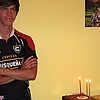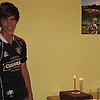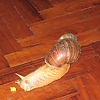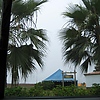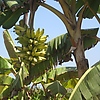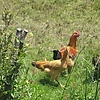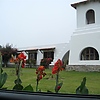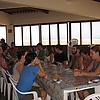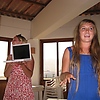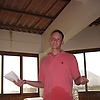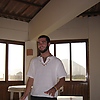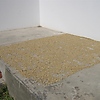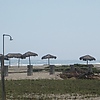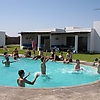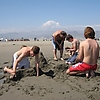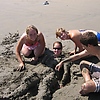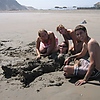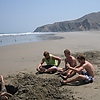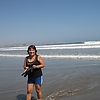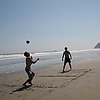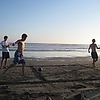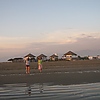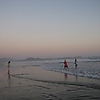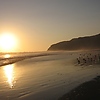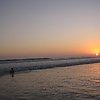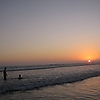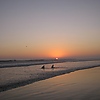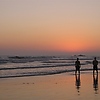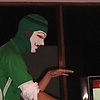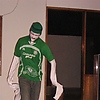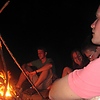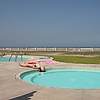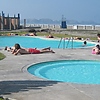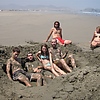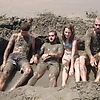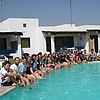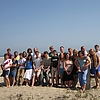Spring 2008 SST Unit in Peru
The Spring 2008 SST Unit has returned, but we'll leave the pictures and stories here
Thu, 10 Jan 2008Safe arrival Last night, with much anticipation, we greeted 23 surprisingly energetic young
people at the Jorge Chávez Lima-Callao International Airport. Their plane
from Houston landed before midnight, but by the time they were through
customs, it was close to 1 a.m. After sharing a few favorite Peruvian snacks (Sublime chocolate and Inca
Kola), we dropped them off at a hostel not far from the Goshen apartment
in Miraflores, Home Peru. With any luck, they'll get a decent night's
sleep before Thursday's full schedule of orientation. We are still putting faces and names together for many and are looking
forward to getting better acquainted in the coming weeks! Following
orientation, at around 5 p.m., students will meet their host families and
have a chance to begin adjusting to their new surroundings as well as
summer temperatures and Castellano...
Posted at 09:06 #
Sat, 12 Jan 2008
Getting Oriented: To Peru & Our Families
Starting later in the morning than planned, we worked hard to keep the day moving and lively - especially with 23 people piled into our living room on one of our hottest summer days so far!
We started out with a time of worship, with Jake testing out our new unit guitar, and Scott L volunteering to serve as song leader. Even with fans and traffic noise, our singing sounded excellent!
Oswaldo, Celia's husband and one of our Spanish teachers, spoke to us about Peru and Culture Shock. He also offered us many practical words of wisdom for adapting to daily life here and getting along with our host families.
For lunch, we divided into 4 groups that each went to a different menucito restaurant. There we were able to use our castellano, visit, and enjoy our first taste of Peruvian food, with 2 courses for around $3.00.
Some new tastes today: Papa a la Huancaína, Sopa a la minuta, Palta rellena, Lomo saltado, Saltado de pollo, emolientes...
Those who were interested also had a chance to make purchases in a local grocery and change some dollars into nuevo soles.
During the afternoon, we flew through the entire syllabus and orientation handbook, and spent the last half hour practicing ways we might greet our families.
Arriving back at Home Peru, several families were already eagerly waiting for us...
Since it is Summer Vacation here, some families have just returned from travels. Tyler's host parents are still in Florida visiting a grandchild, so his family member-housekeeper, Julia, and his Tio Pedro came to greet him.
Here are our first family photos as everyone headed to their host homes for cena and settling in:
Posted at 09:26 #
Sun, 13 Jan 2008
An Introduction to Lima: From the High Ground to the Shoreline
We’re starting in the heart of Lima, the Plaza de Armas, which is the city’s central square, also known as the Plaza Mayor. The pattern evident here is repeated in cities throughout the country, with spiritual and political powers sharing prime real estate along the commons. To your right you can see the Cathedral (you can come back later to tour the inside of the church for 10 soles, or about $3, or even better, attend a free Mass on Sunday morning).
Up ahead is the President’s Palace, built on a site where the Spaniards found an indigenous temple, a construction strategy repeated elsewhere, as if to erase signs of a competing culture. Circling around the plaza, you can see the municipal building for the city government, another stakeholder. The days of bullfights in the plaza are long since gone; now the only animals to be seen are dogs, including one whose owner dresses him with a coat and sunglasses and parades him around to be photographed.
If we hurry, we can get to the cross on the hill before lunch. Just behind the palace, we drive over the Rimac river, which seems more like a creek in a dry desert gully (it almost never rains in Lima). As we begin to climb the road that leads to Cerro San Cristobal, we need to close the bus windows; the people who live in the shantytown here are poor, and a camera or bag might quickly disappear. The streets are so narrow that we have to stop to let an oncoming cab find a place to pull over. Once at the top, we take 20 minutes to walk around, enjoying the best view to be had of the sprawling city of Lima. We can see almost to the ocean, but for a haze in the distance.
We make it back to the Plaza de Armas in time to watch the changing of the presidential guard, a blend of brass and high-stepping that always draws a crowd. From there we walk along a pedestrian street that links to another main square, the Plaza de San Martin, which celebrates José de San Martín, the liberator of Peru and Chile, with a statue.
Lunch is served upstairs at the Hotel Bolivar, which fronts on the plaza (stewed chicken with exotic rice and mashed potatoes, and for dessert cake with lucuma filling). It’s a power lunch, SST style, with all of us around one long table. The glory days of the hotel are now past, but the workers who own the hotel do their best to maintain touches of elegance in a place built to receive presidents and royalty.
Before leaving the downtown, we take a stroll through Chinatown (the largest in Latin America) and walk past the central market where young street musicians are dancing and playing afro-peruvian style music.
We make our way back to Miraflores, traveling through a variety of Lima neighborhoods, with Celia pointing out some of our host homes along the way.
Our bus ride ends at the Pacific Ocean, with the afternoon sun still strong. Picking our way from stone to stone, we walk out to the end of a long breakwater, visiting with fishermen along the way. Overhead, we see the paragliders taking off from the cliffs, in flights that hug the shore. We keep up a good pace as we walk back to Goshen Tambo, ready to meet host families for a first weekend together in Peru.
Posted at 22:59 #
Wed, 16 Jan 2008
Huaca Pucllana, Temple of the Sea Worshippers
Huaca Pucllana, a pre-Inca pyramid of adobe bricks, was one of the most important administrative and ceremonial centers of the Lima culture, settled in the areas of the Chancay, Chillón, Rimac, and Lurín valleys from 200 A.D. – 700 A.D. It is impressive in part because the site sits in the middle of the city, with high-rises in every direction. But when you follow dirt paths past the adobe walls on the site, entering inner rooms once filled with offerings to the gods, it’s possible to feel transported.
Whether you would want to be transported depends on what you imagine the Lima people who once lived here to be doing. The ritual banquet would be nice. Our guide, Pedro Vargas, a history teacher and archeologist at the site, told us that the indigenous people who lived here farmed and fished and apparently ate well.
But he also described human sacrifices – comida de los dioses, or food of the gods – that involved a kind of dissection we would not wish on anyone. Girls and women were sacrificed, he said, suggesting a matriarchal society in which the most valued members of the community were presented as gifts.
Perhaps not surprising, since they lived so close to the Pacific, our guide said, the Lima people directed their worship to the sea, and revered the moon and the shark, among others, as is evident in their pottery.
Work continues at the site. We could see several researchers in the distance, restoring a temple wall. We also saw a Peruvian hairless dog and other native animals, including a silent breed of duck, llamas, alpacas, and cuy (guinea pigs).
Between us, we confirmed that what they said was true: at Huaca Pucllana the dogs are friendly and the llamas kiss.
Posted at 20:44 #
Sat, 19 Jan 2008
Hanging Out at the Foreign Ministry
By prior arrangement, we arrived at the door of the Foreign Ministry in Lima, rang the bell, and waited. And waited. When some students went out to buy water, the rest waited.
We had arrived to take a tour of El Palacio Torre Tagle, regarded as one of the most magnificent Colonial homes in Lima. The house, built in 1735 for the family of Don Jose Bernardo de Tagle y Bracho (a name that bespeaks power and urgently calls for a nickname), is now used by the Ministry of Foreign Affairs. We wanted to see the carved wooden balconies, among other things.
But the curator, whom we had been told would serve as our tour guide, was a no-show. After a long while – did we mention that the students remained remarkably pleasant and patient while they waited? – a guard escorted us through bronze-studded doors to the courtyard, where we had a look at a Cinderella-type carriage parked in a side room and the grand staircase leading to the first floor.
In fairness to the Foreign Ministry, we later learned that earlier that day the place had been abuzz with a meeting of ambassadors. The very next day Peru filed suit against Chile in international court, seeking a larger share of fishing waters in the Pacific Ocean. There is no love lost between these two nations.
On our tour of downtown Lima, we met with more success at the Congressional hall. After receiving official visitor badges and walking through a security checkpoint, we had a look around.
Our two guides, Ricardo and Jair, were full of anecdotes and notable facts. Did you know that 30 percent of the congressional representatives in Peru are women, the highest percentage in South America? Or that the European artist who designed the stained-glass coat of arms for the ceiling in the Senate chambers mistakenly put a llama where a vicuna should have been?
And did you know that if you leave the Congressional building and walk a couple of blocks west toward the Plaza de Armas you will come to an ice-cream shop where you can get a pretty good cone of D'Onofrio ice cream?
Posted at 17:32 #
Sun, 20 Jan 2008
Tambo: Time for reflection, relaxation -- and celebration.
For those who haven't read the blog from previous groups, following is a reminder of why we call the Goshen apartment, “Goshen Tambo.”
The Quechua word Tambo is from the time of the Incas. A "chasquitambo" in Quechua was a resting station for the Incan runners who ran messages and other items across the empire. The runner, or chasqui, would come to these resting places, or Tambos, every 15 - 20 k. along the Incan highways and byways and switch runners; the fresh one waiting to resume the journey with the message or whatever the previous runner had been carrying.
Wednesday gatherings are like a Tambo in that they provide a resting place and refuge from the intensity of SST. Goshen Tambo includes lunch and worship, which will be planned each week by a different group of students, along with time for group discussion, reflection – and plenty of rest and relaxation!
Lunches are generally prepared by Mervi (CJ's host mother), who helps introduce us to many traditional Peruvian foods.
This week happened to be Scott's birthday, so we had an excuse to celebrate with chocolate cake. Thanks to a gift from thoughtful parents back in Indiana, we also enjoyed a treat of ice cream flown in from the jungle. Feliz cumpleaños!
Posted at 23:01 #
A Good Morning for Crafts and Water
We boarded a microbus, 12 students and some support staff, carrying cases of water, coloring books, crayons, beads for making jewelry, paper for making origami, a soccer ball, a hacky sack, Ritz crackers.
Reaching the edge of the city, the bus started climbing, first through Pamplona Baja, or lower Pamplona, and then Pamplona Alta, where the blacktop turned to sandy dirt roads. The Pamplonas are considered pueblos jovenes, or young towns.
For decades, people from the mountains and jungles have traveled to Lima for jobs and schools, looking for opportunities. In the 1980s and early 1990s, they also fled their homes in the countryside as the Shining Path terrorists battled police forces. They would pitch reed mats along steep, sandy hillsides in places like Pamplona. With time, they would use plywood or brick to firm up walls, and add electricity and a water tank. The poverty remained, just in different degrees.
Milagros, a young woman with a vision for a church daycare center in Pamplona and oversight of a small three-room building in which to make it happen, has been taking groups of Goshen College students to the site for several years. In the fall, students painted the outside of the building green. Over the weekend, the first half of our group went to spend a couple of hours playing with more than 50 children.
The temperature was in the mid-70s, but it felt hotter. Early on, some played soccer on a sand field nearby. But soon, shirts drenched, they joined the other children who were trying to stay cool inside the building, drinking lots of water and chocolate milk.
The children tried their hands at origami (especially birds). They colored pictures. They strung bead necklaces and bracelets. A few students led rounds of “Head, shoulders, knees and toes” in both Spanish and English. When it was time to go, there were hugs all around. We promised to be back the next week, with 13 more friends, maybe a guitar, and definitely lots of water.
Posted at 23:06 #
Tue, 22 Jan 2008
Playing Soccer (Almost) Till the Sun Goes Down
"They like to watch soccer here," Dan told some friends, "but I guess they don’t really go out and play it." Apparently someone had misled him; because two days off the plane, I was watching him and four other students engage a pack of young Peruvian teenagers in an intense game.
They played in a park in the depths of the city, a sprawling area of small cement courts and grass fields worn to dust. Intermittent playgrounds and palm trees rose in between the fields, but the surrounding apartment buildings dwarfed them.
It took a while to reserve a field; apparently "futbol" is not only for the television. Despite the hot late afternoon sun, each field was occupied, and people watched from the sidelines, not hesitating to call out "atras!" or "tuyo!" to their friends and family members.
A large group of onlookers gathered to watch the norteamericanos play, clearly curious about their abilities. An occasional passerby watched the audience, looking for an opportunity to snatch the players´ backpacks from the sidelines.
Unlike players in the States, these boys (no girls played) had to slip and stumble on the slippery cement. They had no nets, only rusty white frames. However, these factors seemed only to improve their balance and coordination. They knew how to keep a ball close, so that it wouldn’t hit anyone by the edge. They knew how to steal the pelota with a quick twist of a foot, a practiced skill in the overcrowded fields.
The outfits of the players varied. A surprising number wore jerseys, the red and blue of Barcelona, the black and red of Milan, and the white and pale blue of Argentina. Most wore athletic shoes of some sort because cleats are no use without turf. Some wore street shoes. No one played without a shirt. No one wore shinguards.
Eventually Scott’s host father called the game to a halt. They could play only until dusk, because it wasn’t safe to be out after dark. The players set a time for the very next day and wandered off to the Metro to buy refrescos, grins on their faces.
Posted at 18:23 #
Thu, 24 Jan 2008
Getting Around the Biggest City I've Ever Lived In
At first glance, the bus system of Lima seems a little bit ... how should I put this ... ridículo.
Before coming to Lima, I figured I’d be able to survive well living in a big city. I lived in Albuquerque for a year and had the bus system down pat; I traveled to Europe and could easily decipher the bus and subway maps.
However, here in Lima there’s just one problem – there are no transportation system maps!
Basically it’s a bit of a free-for-all; the local government does not control the bus system as we would expect in an American city. Rather, private companies convert vans and buses of all sizes into working public transportation vehicles, locally called kombis. Because of the competing companies, and differing bus routes operated by each outfit, it would be impossible to produce a map of all the possible bus routes in Lima. Well, I guess you could, but it would just be a wild mess of multi-colored lines over the already chaotic roads that make up the various areas of the city.
So, how do you figure out what bus to take? Well, fortunately you can simply recognize specific buses by their appearance -- in fact, by four aspects of their appearance: the color, the numbers, the letters, and the street names.
Various buses have differing colors based on what company they are owned by, but the color will also sometimes represent what route the bus runs. I guess that’s not particularly specific, so let’s move on to the numbers.
The problem is that there will be more than one number. First is the route number – the one you want to look for. But watch out because each kombi will also have numbers that distinguish it from the rest of the fleet of that company, as well as registration numbers that are given by the state. So, you really have to look hard sometimes to find the route number that you are looking for.
In addition, you have to be aware of the third aspect of the appearance, the letters. Oftentimes routes will have variations, which will be represented by letters, A, B, C, etc. For example, I take the 45B bus to school in the morning, and I have to make sure I don’t grab the 45A, because I really have no idea where that would take me. One note though: sometimes the number and letter will be together in one place on the front of the bus, or the 45 might be one place, and the B will be in another corner of the windshield, so watch carefully!
Finally, the names of some of the major streets that a bus travels on will usually be written on the side of the bus. So, it’s often a good idea to check those out before you get on. The front of the bus will also have two names, usually of neighborhoods, written above the windshield, that represent where the bus goes to or from.
I did mention that it’s easy to pick out a bus based on its appearance, right? One thing about the names written on a kombi – they’re not always necessarily correct. The vehicle might be old and be traveling a different route than what the outside specifies. So, it’s a good idea to ask as you get on the kombi if it will be going to the place where you want to go. And be specific! Ask for the intersection you want, or the block number of the street you want.
In the States you’d just ask the driver of the bus, right? Well, don’t even attempt that in Lima – the kombi drivers have some pretty insane traffic to deal with and have to keep their attention on the road. Instead there is a second guy on each kombi, the cobrador, who is like the doorman of the vehicle – he’s who you want to ask.
The cobrador is probably my favorite part of the Peruvian transportation system. They usually sort of half hang out the bus and shout at people like an auctioneer selling a quilt at a Mennonite relief sale. “Toda la Marina! Toda la Marina!” they might shout as they point at various people on the sidewalk trying to get them to board the kombi. All the while they are responsible for walking around the kombi asking for pasajes, or fares.
And walking up and down the isle of a kombi is not an easy task, as they are usually packed to the brim with people. I haven’t decided what I like less, sitting in an aisle seat with people standing in the aisle crowded up next to me, or standing in the aisle, crowding the poor guy in the seat beside me and hanging on tight as the kombi rapidly speeds up and slows down between stops.
Lima’s public transpo is obviously a bit confusing and exciting and I’m sure I could easily keep writing about experiences on kombis.
For now I’ll just leave you with one final word of advice, make sure you shout out to the cobrador when you want to get off, because it’s a fast-paced world on a kombi and it’s not going to slow down just for you.
Posted at 15:41 #
Fri, 25 Jan 2008
First a Swim, and Then a Sobering Dose of History
We spent an afternoon there earlier this week. First we stopped by the building where C.J. and Philip live to pick up pack lunches (C.J.’s mom, Mervy, prepares many of our group meals, and she had triple-decker sandwiches ready for us). We kept on driving through Callao until we reached La Punta, or The Point, which juts out into the Pacific. The beach we ended up at featured a rocky shoreline and impressive surf. We enjoyed a couple of hours in the sun.
From there, we went to the Museo del Real Felipe, named after a king of Spain. We learned that the fort was built after an earthquake and tsunami in 1746 pretty well leveled the city. The thinking was that the fort would provide protection from pirates. But as it turned out, fighting around the fort was heaviest during the independence wars around the 1820s. Some of the time, the Royalists, who favored maintaining allegiance to Spain, controlled the fort; at other points during the conflict the patriots, who wished to sever those ties, had the run of the fort.
One would not have wanted to be a patriot in captivity during the Royalist reign at Real Felipe, according to our guide. We had a chance to visit the dungeon and hear about how prisoners would get bread and water -- and that, only twice a week. Several people commented on how creepy it was to walk back to the inner sanctum of the dungeon, following a pathway that was barely wide enough for a midsize person with a backpack to squeeze through.
The fort tells of the weaponry and strongarm tactics apparent in earlier chapters of Peru’s history. Canons, canons, everywhere. Swords of all lengths and cuts. A bust of Tupac Amaru II, who led an Indian insurrection in 1780, only to witness the death of his wife and family, and then to be quartered by horses.
From the lower depths, we walked out into the sunshine and climbed the steps of the Queen’s Tower, which affords a glorious view of the bay of Callao and the islands of San Lorenzo in the distance. The photos, we hope, were worth the climb. It certainly was nice to get out of the dungeon.
Posted at 23:14 #
Thu, 31 Jan 2008
Putting Paper to Flight, Regions to Memory Each trip to Pueblo Joven Pamplona,
a maturing shantytown on the outskirts of Lima, is
like a conversation among new friends. Depending
on the day and on who happens to be there, the
time together will unfold as it only could at that
particular moment.
One of the highlights of our second visit to
Pamplona this year was discovering how perfect the
conditions were for flying paper airplanes. Who
knew. Just outside the little church social hall built
on the side of a sand hill, there is a ledge.
Several students and a group of boys began folding
planes. The boys would then launch them and when
the planes caught the wind just right, they would
soar down the hill, landing in other dirt yards. The
boys would give chase and start over.
Meanwhile, inside the building children were busily
engaged in making jewelry by stringing together an
assortment of beads; creating watercolor drawings;
and doing puzzles featuring the country of Peru
and its 25 regions, or states.
The keen interest in the puzzles was a nice
surprise. We have the puzzles on a shelf at Goshen
Tambo and only put them in a bag at the last
minute before heading to Pamplona. As it
happened, all four puzzles were in use almost the
whole time we were there.
Do you know the largest region? (Loreto, in the
northeast jungle). How about the smallest? Hint: it’s
the place students fly in and out of, and the place
where two students in the group are living. (Callao,
just north of Lima). The region that looks like a
dragon? (Ucayali, with a tail that sweeps away into
Brazil).
P.S. We also were pleased to see that the light
green paint applied by GC students to the outside
of the building last fall has held up well. We were
worried that the paint had been too thinned out
with water, but the covering looks good.
Posted at 23:02 #
Fri, 1 Feb 2008
Hide and Seek Is Saved by Pressing 1
"Mira, Mateo . . ." was all I really caught as the rest of the sentence slurred together and got swept away in the cool evening breeze.
"Ay! El no entiende," said Gonsalo, a neighborhood kid who was thoroughly frustrated by the fact that I still didn't understand the intricacies of "escondidas con pelota."
Rolling his dark brown eyes he uttered an exasperated sigh and swung himself around to yell at my brother Jano, "Jano, explicale."
I knew it wasn't going to help. Jano slurred his speech more profoundly, talked more softly, and spoke more rapidly than any of the kids in the neighborhood. Even if I could have understood what he was saying it wouldn't have mattered because every other kid that was listening felt it was their job to interject and add nuance to every rule that Jano was explaining. When it was apparent that I still didn't get it, a slow hiss escaped through the gap between Jano's two front teeth, and he plopped himself down on the square bench that sat in the corner of the plaza.
A few of the younger kids piped and squeaked at me, hoping that something would click in my mind that would allow me to understand. One "chiquito chibolo," a really little kid named Jose who had something very important to tell me, kept digging his index finger into my ribs to get my attention.
We'd kept up this comical routine of hurried explanation reciprocated by utter confusion for about 10 minutes by this point, and this is what I knew. "Escondidas con pelota" meant literally, "hide and seek with ball," and like any other game of hide and seek I was to hide and try not to get caught. But it beat the heck out of me how I got caught. What's more, I could save everybody by doing something to the ball, but for all I knew I might have had to get down on all fours and kiss the flat, crusty thing.
Luckily for me after a couple more failed attempts to explain the game and not a few "groserias," Claudio came and saved the day.
Claudio was Peruvian through and through. He had short, straight black hair, big brown eyes, coffee-colored skin and a keen interest in "futbol." But he was also American. He lived in New Jersey for all of the year except for a couple of weeks, spoke perfect English with the slightest East Coast accent, and loved the movie "Tommy Neutron." With the help of this 9-year-old transnational child I was ready to play in less than 2 minutes.
This past fall I remember watching one of the Republican debates on national television and one specific tirade sticks in my memory. One of the lower-tier candidates speaking on the subject of immigration just went off about automated phone messages. Pounding fist on podium he vented to the entire nation: "This is America. We speak English here. I am sick and tired of hearing '1 for English, 2 for Espanol' every time I pick up the phone."
How much violence in this world has been caused because of ethnic and cultural intolerance? And how much of this conflict could have been averted by the simple act of sitting down and getting to know somebody? If everyone in the world was like Claudio and simply knew one other language besides their mother tongue, think of the communicative possibilities. Perhaps the world would be a better place.
Posted at 16:43 #
Mon, 4 Feb 2008
Fancy Footwork on the Third Floor
So, for a change of pace, we headed up to the third floor, the gala ballroom surrounded by windows. Our mission: learn to dance the marinera limeno, a version of the "national dance of Peru," usually with a handkerchief as a prop; the festejo, a vigorous dance whose roots reflect a celebration of the emancipation of slaves; the salsa, which also has African influences and a fast step; the merengue; and the huaylas folk dance.
Our dance instructors, Pedro and Cari, demonstrated each dance form first. Then we had the women practice with Cari, while the guys followed Pedro's steps as best as they could. And finally we divided up into couples for a formal run-through.
A host sister and her friend, as well as several young women from Cenfotur, a school where Celia and Oswaldo also teach language classes, joined us to help correct a gender imbalance in the SST group (15 males, 8 females).
There didn't seem to be much nervousness about dancing in a crowd. But we did have one scare. The afternoon sun was baking, and we tried to cool off the third floor by running ceiling fans. But the fan switch failed at one point, and burst into flames. A couple of alert students cut off the switch and managed to blow out the flames like a birthday candle.
And the dance went on.
Posted at 23:38 #
Tue, 5 Feb 2008
A Towering Challenge Made of Words
Language, one of the most important aspects of our lives, whether it be spoken or understood, stands front and center on SST. The people who prepare us SSTers for our semester repeat one thing over and over: try not to have expectations. But, of course, I did. I had some high expectations for my language skills. I knew it would be difficult, but I thought the language would come eventually.
The reality, now that I´m here on South American turf, is turning out to be a different story. Spanish, or Castellano, is the first part of this language predicament. I came into SST with little knowledge of Spanish and knew I couldn´t converse fluidly or comprehensively enough to save myself. I was reasonably comfortable with what I knew, however, and expected to be on my way to fluency by the end. Pretty high expectations, no?
The first few days my Castellano skyrocketed. I learned some key phrases, began to understand, and started to fine-tune my speaking skills. But, much to my disappointment, my language skills seem to have cut the engine and begun the descent. With every day and every new word, there are a thousand other words I realize I don´t know. Most of the time I still struggle to understand my abuelo (grandfather), my sister, and my father. And my sentence-forming is nearly nonexistent.
I often wonder if I´m doing anything wrong. Should I be working harder? Speaking more? Spending less time with other SSTers? What is a good balance between immersing oneself in the culture and taking "English breaks?"
With my lack of fluency in Castellano, another part of the language that has actually helped in many ways is body language. It really supplements understanding when someone from either end is just not grasping the point.
My abuelo is the master of body language. He moves around and flails his arms as his inflection gets louder and more rushed. I´ve seen a range of imitations from the prowling, growling of a tiger to the loud flapping and squawking of a loro (parrot). Maybe, I sometimes wonder, if I had body language skills like my abuelo, I would learn more Castellano.
The third part of the language dilemma that detracts from my proficiency is English. English often gets in the way of learning Castellano because it´s so tempting to revert back to using it.
English, however, also has a funny way of escaping me here. It almost seems to leave in punishment for relying on it too much. English words and correct spelling tend to flee my vocabulary, and instead I produce garbled sentences with less worth than my attempts at Castellano. By the end of SST, I predict I will be a person with two half languages. Then again, I think I´m done having expectations.
Language is such an interesting phenomenon to study. How we learn it, how we pick it up, who picks it up best, and for what reasons.
Thinking about the ancient cultures and language here in Peru, I was recently reminded of the story of the Tower of Babel in Genesis. Where would we be if God hadn´t frustrated the language of the early humans? Certainly not with our rich and diverse histories of culture and language! So, even though sometimes I wish God would just grant me the power to speak fluent Castellano, I´m O.K. with the thought that God decided to take things back in hand, give us many rich languages, spread us all over the earth, and make us gain character through learning the languages of one another.
Posted at 08:17 #
Fri, 8 Feb 2008
Sampling Music and Farm Life in Chincha
We were running a little late when we arrived at the
central plaza in Chincha. We had left
shortly after 7:30 from Goshen Tambo that
morning, and during the three-hour bus ride south
along the Pan-American Highway we stopped once
for bathrooms and a second time to pick up some
bananas and other fruit at a stand. Fortunately,
Pastor Tolentino, a friend from Chincha, was
patiently waiting for us at the plaza, along with his
son-in-law, Arturo Prieto, who would be our guide
for the morning.
Arturo is a technician at La Calera, a family-
owned farm of more than 1,000 hectares, or
roughly 2,470 acres. Once we passed through two
checkpoints, being waved on by guards with
walkie-talkies, we discovered a lush farm in a
valley in the middle of the arid desert that is Peru’s
coast.
We drove along sandy lanes with fields of green on
either side: avocados, tangelos, grapes. We also
saw mountains of bagged corn feed and long sheds
with caged chickens. As it happens, La Calera is the
leading producer of eggs for export in Peru. For at
least some of the 2,000 employees, and perhaps
executive guests from abroad, there is a manicured
polo field, which we glimpsed from our bus
windows.
The farm’s success depends in part on a great
location, as it straddles two rivers, which feed an
extensive irrigation system. One of the highlights
of our stay was walking over a swaying cable bridge
that crossed one of the rivers to newly acquired
land.
From there we headed into the city of Chincha for
lunch, which for some included a favorite local dish
known as carapulcra, a dried potato stew.
We had a bit of time before our next stop at the
Ballumbrosio home in the El Carmen district, and so
we rested for a while at the plaza.
Well, some of us rested. Others got out a soccer
ball, and eventually took to the street for a pick-up
game with young boys from the community, with
Our Lady of El Carmen Roman Catholic
Church as the backdrop, still scarred from the
earthquake that killed more than 500 people and
toppled homes across the region in August.
(Daniel will be doing construction work in Chincha
during the service term that begins in two
weeks).
In the fall we enjoyed a concert with the family
of Amador Ballumbrosio, now in his 80s, the
dean of Afro-Peruvian music who is best known for
his skill in zapateo, a tap dance with
intricate rhythms. At the time, the family was still
repairing its home from the earthquake, and so we
met at a local hotel. This time we joined the family
in their home, with chairs and benches ringing the
living room. Amador Ballumbrosio was there to
greet us and answer a few questions, though he did
not join in the music making.
The young men in the family formed a percussion
line, using instruments like the cajón, a simple box
drum that looks like a stool, and the quijada de
burro, the jawbone of a donkey. The girls in the
family danced in the middle of the room, at one
point pulling most of us up from our seats to join
them on the dance floor.
Toward the end of the program, we had a chance to
try out some of the instruments. Playing and
dancing along with the Ballumbrosio family, we
realized that the rhythms aren’t as easy to master
as they might seem. With quite a few newly
released CDs in hand, along with recommendations
on where to buy the best cajóns in Lima, we
boarded the bus for our trip home.
Posted at 14:49 #
Sun, 10 Feb 2008
A Handshake and a Kind Word in Barranco Tyler shares a journal entry:
Rachel and I are leading the group home after an afternoon touring the San Francisco Cathedral and catacombs. I move behind her as we approach a short, older-looking Peruvian man on the narrow sidewalk with taxis driving so close that you wouldn’t want to get too close to the edge. As we get closer, the gaze of the Peruvian draws my eyes down toward him until our eyes meet.
“Que tal, amigo?” he says with a sly look on his face.
“Bien,” we answer together while striding past the overly friendly man.
“You must be Americans,” he said as we stride past him without engaging in conversation.
“Si,” I quickly answer over my shoulder.
A block away, Rachel turns to me and says, “I feel bad ignoring people like that. We’re representing the U.S. and I don’t want people to think we aren’t friendly.”
I agree, but tell her not to worry about what one person on the street thinks. A few minutes later, I’m licking my chocolate ice cream and forget about the old man on the street corner.
I’ve left the group and I want to explore Barranco, my home district in Lima, a little more on my own. I get off the bus a couple blocks early, walk through the park with an empty fountain and rows of red salvia flowers. The park leads me to a path that goes down to the Pacific, a path that my family's maid, Julia, showed me my first week in Lima. I descend a few flights of stairs that lead to the familiar trail. When I get near the bottom, I see a tall young Peruvian, probably in his late 20’s, in a yellow T-shirt and khaki shorts. He makes eye contact with me and lights up like a old reunited friend.
“Que tal?” he asks me.
“Bien,” I answer as we pass each other, a woman to his side.
“What country are you from?” he asks in a quick Spanish that I only guess because I caught the familiar word “pais,” meaning “country” in English. I quickly decide to tell the truth and say, “Los Estados Unidos,” instead of Canada. He comes back down a couple stairs to greet me, and his friend keeps moving to the top of the stairs. With his hand stretched out toward mine, I decide not to ignore him like the man I ignored earlier in the day. I meet his hand halfway with a firm handshake.
“Are you a tourist?” I understand the question in Spanish a lot better since I was expecting it.
“No, I’m a student living in Lima for six weeks and Mancos for six more.” He’s impressed: not only am I living here but I can speak a little Spanish. He shakes my hand again.
“How do you like Lima?”
“I think it’s nice.”
“Which parts? Miraflores and Barranco?”
“No, I’ve been to other parts. I like them all.”
He asks me a couple more questions and shakes my hand again after I answer.
“You speak good Spanish,” he tells me.
I know it’s a lie but I thank him anyway. He asks me another question, then his friend at the top of the stairs calls him to go.
“Mucho gusto,” I say as he shakes my hand with a star-struck look still on his face.
“Ciao, amigo,” and he runs up the stairs.
Posted at 18:03 #
Mon, 11 Feb 2008
Becoming 'Bebe Robusto' Scott shares a journal entry:
"Ven, hijito, ven," coos my host mother. Come, little son, come. "It’s time for supper."
Being referred to as a son by a woman from another country wasn’t something that was completely new to me. I’ve been an exchange student once before. Through my homestay in Japan as a high schooler, I felt the love of a complete stranger, and became a member of a family that I barely knew.
But that experience didn’t quite prepare me for the love I would receive from my host mother here in Peru. It became clear fairly early on that I was a true member of the family ... at least in my mother’s eyes. My second night here in Peru, she held my arm tight as we walked through the streets of Lima. It was if I was a long-lost son, finally back in the clutches of his mother.
As soon as I return home each afternoon, she comes straight to me, kisses my cheek, and asks how her "little son’s" day has been. Every morning, she sends me off to school "with God by my side."
All of these actions have touched my heart, but none have meant as much to me as one unexpected nickname my mother gave me that second day as she clutched my arm. She had just finished explaining to me that our neighborhood could be dangerous at night, and that normally, she would not walk the streets alone. But that night, she told me, everything was alright, because she had her "bebe robusto" by her side.
From that moment on, I was her "sturdy, robust baby." And as cheesy as some may view this, and as funny as the host brothers of my friends find it, to me, it’s incredibly touching. A woman I had met 48 hours earlier had just made me a huge part of her life. In two days, I had already become her baby. (And she wasn’t shy about it either.) All relatives, friends of the family, and even a few lucky students from the Goshen group know that I am her "bebe robusto." A stranger who barely knows me, yet loves me so much -- it is humbling to a degree I can’t quite put into words.
The connection between us seems to go beyond nicknames as well. The third morning I was a part of her household, Mami called me to a breakfast of bread, cheese and a special type of meat. I remarked to her how much I enjoyed the meal. She turned to me with her characteristically smiling face and said, "I knew you would like it, because I am your mother." Honestly, I nearly cried. I wanted to, but I knew that a big smile plastered on my face might go over a bit better, so I smiled big and hugged her.
That smile stayed on my face the rest of the day. It returns to me every day when I wake up, my mother waiting to make me breakfast; every day that I return to her smiling face; and anytime we sit down to talk about life. I feel blessed, a stranger in a new land, to have such an amazing love bestowed upon me, no questions asked. I truly feel like her "bebe robusto."
Posted at 15:31 #
Wed, 13 Feb 2008
Friends, From a Distance Sometimes you just have to jump in; so it was when we went to the Islas Palomino, or the Palomino Islands.
We had been riding for about an hour and a half to reach this place, but it could have been a world away. From the boat, maybe a hundred yards offshore, we could see hundreds, if not thousands, of sea lions, all in motion. They blended so well against the rocks that if they had stayed still, we might have missed them. As it was, they were waving flappers, bobbing heads, and slipping into and out of the water. The strangest part of all was chorus of barks, which at times sounded sad and mournful, and at other times sharp and watchful.
With the back platform of the yacht serving as a high diving board, there was no chance to put toes in the water to test the temperature (which was probably a good thing, because it really was cold, even on summer day). Our lead guide, a trained lifeguard, was in the water, telling us to hurry. It was either leap in, or stay on the boat. Within a minute or two, all 23 Goshen students were swimming toward the island.
There we stayed for 15 minutes or so, bobbing in our lifejackets. Who was on stage? Who was the audience? Each side was closely eyeing the other. Sea lions took turns swimming out close to us, almost brushing up against us in the surging tide. We might have had one actual touch, but that couldn’t be independently confirmed.
Our guide had warned us not to try to touch the sea lions – stay a few yards away, he had said, out of respect for their sense of appropriate territorial space. No kisses on the cheeks for these slippery guys and gals. We ended up with a very amicable arrangement. We kept our distance, and they kept theirs.
Comments afterward included: “Incredible” and “This was truly a once-in-a-lifetime swim.”
The ride out and back from the port of Callao was also fun. We passed the islands of San Lorenzo, which was once covered with guano (bird droppings prized in Europe as a fertilizer), and El Frontón, site of a former prison.
Back on the boat, they served us hot tea and chips and Inca Kola. We also had packed sandwiches, including peanut butter and jelly. All the way back to Callao, the towels and blankets felt good, even in the setting sun.
Posted at 19:03 #
Thu, 14 Feb 2008
A Mother Knows Best Scott shares a journal entry:
There have been many things on this visit that have altered, modified, or downright changed my thinking toward habits that I have in the United States. However, there was one habit that was able to sneak its way onto the plane and stick with me all the way to my guest home in San Borja. That is my ability to ignore growing heaps of dirty laundry.
Approximately one month into my stay, I had managed to avoid washing everything from the few T-shirts I brought to, yes, even the boxers; if it wasn´t for them and my growing annoyance in "going commando," I might still be without my first load of clean laundry.
It wasn´t until my host mother Marlett looked me in the eyes one morning over a breakfast of bread, butter, and avena (a hot drink like oatmeal) and stated, "Scott, tienes muchas ropas sucia; mañana nos lavaremoslas!" Translation: You have a lot of dirty clothes; tomorrow we are washing them! I didn´t quite know what we are "washing them" meant because it was clear they did not have a washing machine and I wasn´t sure where a laundromat was around me.
I did, however, know they had a clothes line in their back patio, which I sincerely hoped wouldn´t be home for all my clothes in a few hours because that would mean each piece of clothing would need to be washed by hand... by me. Something I wasn´t very excited about.
Fortunately, as it turned out, although there certainly would be a lot of handwashing to complete, it would only involve my ropa interior and quite a few socks. The rest of my clothing would be taken to a laundromat where it would be washed for 7 soles. However, due to the number of clothes I had, I had to pay quite a bit more than the standard 7 soles.
When we returned to the house after dropping off my clothes, my mom pointed me out to the back patio where two hot tubs of water and soap awaited my arrival. For the next two and a half hours, with my mother patiently by my side, I scrubbed and scraped away at my dirty clothes until my hands were red and pruney and I was prepared to go naked for the rest of my time here just to escape from having to ever do this again.
I was ready to be done with the laundry after the first hour, convinced my clothes were clean. But my mother would not let me go until every last piece of clothing was "¡Blanco, blanco!"
Posted at 09:23 #
A Theology of Hope Amy shares a journal entry based on an interview with Pastor Luis Minaya Ballón, general secretary of the Evangelical Church of Peru, the country's largest Protestant denomination. The interview was published in one of our textbooks, The Peru Reader.
The preface states: "Although Protestant missionaries first arrived in Peru in the 1800s, it wasn't until the 1980s that Peruvians began converting in large numbers. By 1990, Protestants numbered more than 1 million people in at least 27 different denominations, including Assembly of God, Baptist, Presbyterian, and Pentecostal." Protestants are still a clear minority. One of our lecturers noted that about 80 percent of Peruvians are Catholic.
"Is Peru Turning Protestant?" I´m not sure, but I don´t trust this guy being interviewed. He says Protestants are doing what Catholics have not done, that they´re working with the poor rather than the rich . . . doing what they can to make the Gospel relevant within that reality (it´s not a hard task).
But I think about Liberation Theology, which was birthed partially in this country through the mind and heart of Gustavo Gutierrez. I can´t remember whether the movement began in the Catholic Church or the Protestant denominations, but I know priests and nuns were killed in El Salvador because they believed a little too strongly in a Gospel that offers freedom for all, starting with the poor. Does it matter where the movement began? I´m thinking it´s more important to ask where the movement lives today.
The Catholic Church said no to Liberation Theology, but the Catholic Church says no to a lot of things, and the people don´t always listen.
Liberation Theology is a theology of the people; it´s born in the reality of the poor and given sustenance there . . . growing, thriving, and spreading. I wonder what influence if any Liberation Theology has had in this country. Its biblical interpretation and ideals are missing from the hierarchical, formal Catholic Church, but I wonder what the people believe, or the few priests that do come in contact with the poor . . . what are their beliefs?
Maybe it’s because I love Liberation Theology’s themes, and maybe it’s because I’m always full of hope when it comes to the church, but I don’t believe Gutierrez’s message was or is lost on the people of Peru. It’s here, in the Protestant as well as the Catholic faith, as present as the Andean religious traditions that are woven in the life and faith of Peruvians. I hear it in the voices of those I interact with, when conversation turns to religion, and I read it in the words of poets and storytellers as they pour their despair and hope simultaneously onto the page.
Posted at 09:32 #
Thu, 28 Feb 2008
Sugar-Rush Potluck in Barranco
Thanks to Celia, our country coordinator, and her husband, Oswaldo, one of our language instructors, we have a standing invitation to Cenfotur (El Centro de Formación en Turismo), which trains students in hotel and tourism management. Both Celia and Oswaldo teach English classes at Cenfotur, which is in Barranco, a short walk from the ocean.
This semester, in celebration of St. Valentine's Day, we arranged a dessert exchange. After lunch in their cafeteria, we went to class with our homemade brownies, while they brought different Peruvian sweets, including crema volteada (flan), chocolate truffles, and mazamorra morada.
Students intermingled in small circle groups, and every so often we rang the bell to remix the groups. The order of the day was giving both groups a chance to sharpen their language skills through bilingual conversation.
After class, the Goshen group was given a tour of the school, followed by English language classes, where they served as interviewees with impeccable Midwestern accents.
Posted at 08:12 #
Sandals for Wandering Feet
The sun snakes through the cortina
Mamá has my breakfast waiting.
“Gloria!” my mamá trills up the stairs.
The bus is full today.
But reaching my stop without incident
The city is alive and breathing
landing on the same pair of sandals
I’ve worn the past four days.
I miss snowboots.
Who knew I would fall in love
with a brand of yogurt
that shares my sister’s name.
“No tienes tiempo. Vamos!”
I kiss her at the door,
our minds already ahead
to where we need to be.
A kind-faced woman offers her lap
to my bag as I stand.
I’m shamed by my surprise.
feels like a prize.
Being directionally challenged
offers extra victory
in every correct move I make.
as I stomp along the street,
the same weary sandals
holding my wandering feet.
Posted at 09:27 #
A “Model City” for the Poor In what has become a Goshen College tradition, we visited Villa El Salvador, a district at the edge of Lima celebrated for its ability to shape a community where once there was only sand.
Our lead textbook, The Peru Reader, offers this introduction: “Until 1971, Villa El Salvador was empty desert south of Lima. By 1990, African-Peruvians from Lima’s decaying center and first- and second-generation migrants from the Amazon and Andean interiors had converted it into a bustling municipality of more than 300,000, recognized internationally as the best organized of Lima’s shantytowns.”
We arrived just in time for lunch in a comedor, a soup kitchen that serves residents from several blocks around. Community kitchens like this one are planted throughout Villa El Salvador, as are parks; one of the district’s tenants is that everyone should live within easy walking distance of open recreational space.
From there, back on our bus, we climbed the hillside to a cemetery to visit the grave of Maria Elena Moyano, an original settler of Villa El Salvador who sought to find a nonviolent path to reform, distancing herself from both the central government of Lima and the Shining Path terrorists. But the Shining Path, which brooked no criticism of its methods, dispatched an assassination squad. Before dying, Moyano would have the last word: “If people organize, pool their efforts, we can defeat the Shining Path. It won’t be easy, but neither is it impossible.”
Villa El Salvador continues to grow. As we walked over the hill to catch a glimpse of the ocean, we saw more recent homes that have been built, as families simply put down their belongings and lay claim to an unofficial lot of sand. One couple was framing out a room with walls of only woven reed.
On our way home, we stopped in a commercial part of the district to browse through leather shops for which Villa El Salvador is well known. Shoes, belts and other leather goods are made locally. One of these times we will have to also visit the furniture section.
Posted at 15:40 #
Sun, 2 Mar 2008
Beauty on the Mountaintop, Upheaval in the Valley
Our tour of the Sacred Valley of the Incas, a gorgeous stretch of villages and ancient ruins along the Urubamba River, began in Cusco, the regional capital. The Incas, incomparable architects with stone, saved some of their finest artistry for Cusco, which they regarded as the center, or “navel,” of the world.
Our guide, Elvis, a native of Cusco who speaks Spanish and English as well as some Quechua, accompanied us the entire way, assisted by Corina, who is studying to become a tourist guide.
In Cusco, one of our stops was the main cathedral along the central plaza, which houses an impressive collection of art. Elvis asked why Jesus appeared with a skirt in some of the pictures created in the Cuzco school of art. Because, he told us, Incan leaders wore skirts, and so the paintings seek to pay highest tribute to Jesus, in a blending of Christian and indigenous beliefs.
We also saw the resting place of Inca Garcilaso de la Vega, the son of a Spanish conqueror and an Indian princess whose sympathetic portrayal of Peru's pre-Columbian traditions won him the affection of the nation's indigenous peoples (an excerpt of his commentaries appears in our Peru Reader). We visited Coricancha, once the Inca Empire’s richest temple all covered in gold, and the fortress of Sacsayhuaman, which overlooks the city.
From Cusco, we prepared to travel by private bus down into the Sacred Valley. An early stop featured photo-ops with a white statue of Jesus, a gift to the people of Cusco from the people of Palestine, our guide told us. Then we watched a traditional Andean healer, Pedro, prepare a special offering to indigenous deities, including pachamama, or mother earth. Into the burnt offering went shells, rice, corn, coca leaves, cookies and candy. When Elvis whispered to Pedro that he was putting in too many sweets, Pedro responded, "Pachamama likes that."
At our first major stop of the day, the ruins in Pisac, we hiked along trails to a fortress complex high on a cliff. We saw the Temple of the Sun, a striking example of masonry. During introductory comments, Elvis pointed out Incan cliffside burial spots across the gorge, long since plundered by grave diggers in search of gold. In the town of Pisac, we took lunch (including quinoa soup, made of an Andean grain) and had time to shop in the market.
The next stop was Ollantaytambo, a town of cobblestone streets that are so narrow one wonders how the many tourist buses that pass through here can keep from getting stuck (many visitors, like us, head to Machu Picchu from the train station here, as it is the last settlement before Aguas Calientes, the town at the foot of Machu Picchu). We were impressed by the many agricultural terraces, or andenes. Several members of the group wandered the hillside overlooking town almost till the sun went down (and the guard, who was worried about missing the start of a soccer game, blew his whistle).
We were up for an early breakfast of bread and scrambled eggs at 6, with a train to catch at 7. By 10 in the morning, we were climbing by bus, switchback by switchback, to the Incan city retreat that a year ago was named one of the seven modern wonders of the world.
Because we were able to secure tickets for an early arrival at Machu Picchu this semester, students were able to wander the complex of buildings, beginning with the Hut of the Caretaker of the Funerary Rock, and still get in a full day of hiking. Almost everyone in the group hiked up the adjoining steep mountain of Huayna Picchu, which looks down on Machu Picchu, as if hovering by helicopter in the clouds. Some also walked a cliff-hugging path to the Inca bridge and some climbed up to Intipunku, the “Sun Gate” notch in the hills above Machu Picchu. Though we went in the rainy season and carried ponchos, we met with only sunshine that day.
Through Elvis and his contacts with tourism and police officials, we were told it would be best to leave Ollantaytambo at 3 in the morning and drive back to the airport in Cusco. A strike was underway, with people protesting a proposed law that would ease restrictions on development near archeological sites (although the law had been amended to grant regional authorities more control). En route, we passed rocks in the road, as well as trees. Each time, we were able to drive around or move the blockades. But just after daybreak, a group of young men halted our bus and began to let air out of the bus tires. Our riding tour ended, as we joined campesinos who were likewise forced to walk into the city of Cusco.
Corina’s mother kindly served us a breakfast of eggs, bread, rice, and tomatoes in her restaurant home at the edge of the city. We arrived at our hostel, tired but well, and had a sharing time on the roof of the hostel. We closed with a prayer of thankfulness for safekeeping and of acknowledgment that we have a deeper appreciation of cries for economic justice in the world.
We had expected to fly back on Friday, but with the two-day strike, which had shut down the airport, we had to rebook our flights for Sunday. During our extended stay, we had opportunities to do more sight-seeing in the city.
Some of us went to the monument in honor of Pachacutec, at the foot of the main street in Cusco, Avenida El Sol. We climbed up the giant statue of the Inca, as if standing on his shoulders to look out over the city. We also enjoyed two excellent meals in Cusco: brick-oven pizza one night, and pollo a la brasa the next.
Posted at 12:14 #
Wed, 5 Mar 2008
Service Visit #1: Cusco and Kataniray
So it is in Cusco. You go about your business and stumble across brilliant polygonal masonry. Nick lives in a house down the hill from Sacsayhuamán, a walled Inca complex that is a mandatory stop for visitors to Cusco. All of the Goshen students toured this fortress, and Nick was fortunate to be able to make a return visit with his host father, Luis, who pointed out various native plants along the way (he uses plants to create natural dyes for his weaving).
While we missed seeing Luis during this visit, we did enjoy dinnertable conversation with his host mother, Angelica, who prepared a wonderful bowl of cream of spinach soup (we still remember her quinoa soup from the last visit four months ago). Nick is working at World Vision, a development organization that brings together sponsors from the U.S. and Europe with children from impoverished homes. His assignment includes tracking incoming and outgoing mail between child and sponsor, including gifts like sweaters, stickers, or pictures. He shared a note that a parent of a Peruvian child was sending to a sponsor: "Ricardo is the 3rd best student in his class. He likes all things."
Meanwhile, across town, Amy is working at an educational center run by her parents, Mario and Rosa, called Helping Hands Cusco. (For more information, visit Helping Hands Cusco). The Quechua name for the center is Grupo Yanapaq Maki Kuna, which means "helping hands." This week more than a dozen students arrived after school for help with homework and to enjoy a safe space in which to play and learn (without the center, some might be on their own at home after school). Early on Amy made scores of Easter cards that will be sold ($3 per card) to help buy materials for the center; each card features a picture of a child and a word of thanks. The goal is to create a full-scale primary school that would serve up to 60 children this year.
The next stop on the trip was the greenhouse and school complex known as Fundación Almería, where Luke, Mark, Michael, and Philip are working. The easiest way to get there from Cusco is to take one of the shared cabs that shuttle back and forth between Cusco and Izcuchaca (2.5 soles for a 30-minute ride); and then take a combi van (1 sol) to the little village of Kataniray. During the walk down a dirt lane to the greenhouse complex, we gave up trying to step clear of the mud and puddles (it's the rainy season in the Andes).
We found the four guys inside one of the greenhouses, picking beans that would later be served to the Almería staff. They were filling up sacks that weighed a good 40 pounds by the time they were hauled out to the drying room. It was T-shirt work, with everyone working up a sweat. The day usually starts at 8:30 and goes until supper time. One of the goals of the nonprofit organization is to teach local farmers better and more profitable agricultural methods. Beginning this week, the guys will also work two mornings a week at the primary school that is on site.
When the guys look up from their work, they can see beautiful mountains in all directions. They have plans to do some hiking in the weeks ahead. Evenings are pretty quiet for Mark, Michael, and Philip, who live in an apartment at the greenhouse complex. Once it gets dark, they said, they usually read. No idle card-playing for these guys (they didn't even bring cards along), but there was talk of starting some Monopoly games.
Meanwhile, Luke heads home after a day at the greenhouse, walking muddy roads to get to his host family's small farm compound. He climbs up stairs in one of the adobe buildings to his bedroom, a room that he shares with his 13-year-old brother, Nilton Cesar. A recent addition to the room is a TV, which didn’t work until Cesar gave it a whack. It now has excellent reception for telenovelas. Just below the bedroom are the sleeping quarters for chickens and roosters, including one who likes to raise the alarm at 3 in the morning.
Luke's host mother, Eufemia, served us a delicious lunch of chicharrones, or fried pork, prepared over an open flame; Peruvian corn, whose kernels are about twice the size of what we eat in the States; potatoes; and Sprite. From time to time we could hear another delicacy, the cuy (or guinea pigs), in search of hiding places in the kitchen. During lunch we had a lesson in some elementary Quechua phrases, since the family is fluent in both Spanish and Quechua. This is what we wanted to say: yusulipayki (thank you).
Posted at 17:47 #
Tue, 11 Mar 2008
Service Visit #2: Chancay
For two animal lovers, the coastal town of Chancay has got to be the closest place to paradise when it comes to service assignments. This was our thought as we saw Kathryn and Melissa in action this week after just 10 days on the job. In Melissa’s own words, their little farm is “complete with 34 horses, 3 friendly alpacas, 2 parrots, 16 Peruvian show chickens, a bunch of dogs and a really friendly family.”
Soon after our arrival that first afternoon, they saddled up two of the horses. The breed is called the Peruvian Paso, descendants of horses brought to Peru by the Spanish conquistadores in the 16th century. These beautiful animals are known as the smoothest riding horses in the world, due to a special, inherited natural four beat lateral gait called paso llano. The paso llano is executed with a distinctive action in the front legs, called termino, a graceful, flowing movement in which the forelegs are rolled towards the outside as the horse strides forward, much like the arm motion of a swimmer.
We watched Kathryn and Melissa give the horses a workout, and then, with a little nudging, they helped each of us mount the horses for a gentle walk around the grounds. Victor, the horse trainer, also let one of the horses display the dancing moves for which they are famous: the graceful Marinera, a coastal dance considered the national dance of Peru. In the coming weeks, Melissa and Kathryn hope to do some dancing and training as well.
One of the mares, Capitana, had her baby the Saturday before our visit. Unable to nurse, the foal needed extra care, which Kathryn and Melissa were able to assist with.
The farm is owned by the son of Fernando Belaúnde, a former president of Peru, who served two terms, from 1963-1968 and from 1980 to 1985. On the day that we left Chancay, Kathryn and Melissa were to be introduced to the owner, who lives in Lima and visits on weekends.
With Melissa’s host father, we toured El Castillo de Chancay, a medieval style castle built between 1924 and 1942 on a rocky cliff overlooking the ocean. Along with samples of mummies, textiles and ceramics from the Chancay culture, it has (according to tourist literature) “10 lounges, 100 rooms, 12 terraces and four fortified towers, some dark caves, flights of steps, and mysterious subterranean passageways leading to the ocean.” All that, plus a hotel, a restaurant, and some very inviting swimming pools, which we didn’t have the time to use.
Before we left for the tour, Melissa’s host mother insisted that we return for lunch. The lovely meal she prepared included homemade ice pops on a stick, papa a la huancaina, a stewed pork dish with rice and sweet potato and, of course, Inca Kola.
A day earlier, we also enjoyed coffee and pastries with Kathryn’s host family and a walk along a pleasant pedestrian street off the Plaza de Armas, lined with shops, restaurants and benches for visiting.
The traditional meal out with just the SSTers that evening took place at a restaurant called El Parque, where Kathryn tried the duck and Melissa went for the saltado de pollo.
Posted at 03:54 #
Thu, 13 Mar 2008
An Urgent Call at the Horse Farm in Chancay
Kathryn shares an entry from her journal.
My host mother woke me up this morning at 8:00, which is early for a Saturday, to say that Victor had called. ¨He wants you to come; the foal was born,¨ she said.
Victor is the manager of the stable where I am doing service, which so far has consisted of riding gorgeous horses and washing them down after. Melissa and I took a mototaxi to the hacienda, and an exhausted Victor led us to Capitana´s stall.
Another worker, a stocky man I’d never been introduced to, came in and slipped a halter on the mare. The filly struggled to her feet and Victor attempted to get her to nurse. The filly couldn’t figure it out, though, butting her nose against the mare’s flank instead.
Victor called me into the stall at this point and asked if I could hold the foal while he milked the mare. The baby was slight, its ribs prominent, and it squirmed in my grip. Then Victor produced a syringe and filled it with milk. I held the baby while he opened its mouth and injected the milk. He repeated this a dozen times and then asked if I would take a turn milking, saying it was hard work.
It was. I’d never even milked a cow before, so I wasn’t sure how to proceed, but once I figured it out, I found out that only the tiniest stream of milk came out. By the time a cup was full, I was sweating. Then I held the filly and he injected the cup’s worth of milk into her mouth.
I found out after this that the foal has some kind of infection in its throat, which means that it is unable to nurse. This is both rare and dangerous; a foal should be nursing on its own within an hour, and if it doesn’t get that initial dose of vitamins and regular subsequent feedings, it will die. Therefore, Victor has to milk the mare and bottle feed the filly every hour for a number of days. This means that he will never get to sleep for more than a half hour at a time. It also means that Melissa’s and my service work will be changing drastically.
I volunteered our help to Victor. I would absolutely love to learn how to care for a foal. Yet what I came away with afterward was the feeling that it doesn’t take much for your world to change. Victor went from spending his time teaching gringas to ride horses to not sleeping at all, and spending his time sweating in a dark stall 24/7. That’s a lot of devotion to a baby horse.
P.S. Three days later, the filly got better and is now self-sufficient. Our service work is back to normal.
Posted at 14:13 #
Service Visit #3: Chimbote
The day began with breakfast -- scrambled eggs, toast, and instant coffee -- in the so-called gringo room, a combination dining room and reading room inside the parish of Our Lady of Perpetual Succor in La Victoria, one of the poorest sections of Chimbote, itself one of the poorest cities in Peru. On any given day in the gringo room one will find volunteers from around the world (right now, if we have this right, the parish staff is joined by two volunteers from Goshen, three from Germany, two from Belgium, and one from England).
Soon we (Scott, Rachel and I) were off to a meeting, with the lead parish priest, Jack Davis, better known as Padre Juan or Father Jack, driving the van. Several dozen community people had gathered at a local youth center, newly built. The pressing question: how to put the enclosed soccer field, classrooms, offices, and rec halls to best use? The youth center is one of many ministries of the parish, which has more than 100 people on its payroll.
As we drove to our next stop, the parish’s hospice, Father Jack called out greetings to passersby and occasionally offered quiet commentary. He pointed out a young man on the street who was suffering from a brain tumor. At the hospice, apparently the only hospice in Peru and perhaps in all of South America, we met some of the nine patients, including Natalia, a wispy woman who quietly asked Father Jack to help find her son, somewhere in Europe, and ask him to come home. From the roof, we could see islands off the western coast, and looking east, could just about make out the distant peak of Mount Huascaran, a beauty of the Andes.
After a lunch of chicken and potatoes and salad (students have a green light to eat the well-washed lettuce here), Scott and Rachel helped their immediate superviser, Benjamin, move into his new office at the youth center. There were pictures to take down, papers to sort, a computer to box up.
Back in the library of the gringo room, I found a book by Henri J.M. Nouwen, Sabbatical Journey: The Diary of His Final Year. Nouwen died on Sept. 21, 1996, three weeks after the final entry. The inscription in the book, a gift for Father Jack, begins: “We are all on a journey that takes us to unexpected places.” Along the way, there is friendship. Nouwen writes: “When I think about the pains and joys of my life, they have little to do with success, money, career, country, or church, but everything to do with friendships.”
Here on SST, Rachel and Scott are immersed in the life of the parish and much of what they are called to do is often to simply be a friend, including reaching out to drug addicts in rehabilitation at the parish’s Talbot House. They described standout moments:
Scott said: “Alex is a 25-year-old regional all-star volleyball player who is now a recovering addict at Talbot House. One day we played pepper volleyball and two-on-two volleyball. It was a lot of fun to see him in his element, doing something besides being cooped up in the rehab center. When we went to the river one day, he talked for half an hour about how he loved to play volleyball, and about how far down drugs had taken him.”
Rachel added: “We went to a river on the third day here. Benjamin said we were taking the guys at the Talbot House to the river. That was when we bonded. We were to walk one or two miles to get there, but they kept making us run to get there more quickly. . . After we were at the river a while, a couple of the guys asked us if we wanted to float downstream. We just let the river take us, ducking under overhanging bushes and branches as we went. Eventually we came to a shallow spot where the river opened up and there we played soccer. . . Now when we see the guys at the center their faces really light up.”
P.S. Rachel and Scott kept the streak going. When we went out for supper, the waitress asked what they wanted to drink. No hesitation: Inca Kola, cold. So far every service group has chosen Inca Kola, the pride of Peruvian soft drinks (though it is owned now by Coca Cola).
Posted at 14:29 #
Mon, 17 Mar 2008
A few more images from Chimbote
Rachel shares a few more photos from life in Chimbote these past several weeks.
Posted at 18:48 #
Service Visit #4: Huaraz
One of the culinary jewels of Peru is the ají condiment, a pepper sauce in varying degrees of picante, nearly always within easy reach on the table. During a visit to Huaraz, Allison mentioned that she had just learned how to make the local version of ají, and that it included at least one surprising ingredient: bread, to give the sauce more body.
Allison is working at a local comedor, preparing meals during the morning and then serving lunch to some 70 children, many of whom would not be assured a well-balanced meal at home. We met Veronica, one of the lead cooks.
Across town, Sara is part of the staff of Casa Hogar, an orphanage for more than 20 children. We caught up with her one morning around 8:30, as she was walking four of the children to a public school (including Ghandi, who is generally sweet, but with a wild side that one just does not expect from a child whose namesake usually makes us think of nonaggression),
Sara is at the orphanage five days a week, helping with meals, homework, and general childcare. While visiting, we spoke with Maria Jesus, the director of Arco Iris, a church-based organization that manages the orphanage and the comedor. They are starting a bakery as well, giving work to young people who otherwise might be running the streets.
Among the highlights of living is Huaraz is having easy access to trails leading into the mountains. Sara and Allison said they can just follow most any uphill street, and with a turn or two, it becomes trail. They try to time their walks to avoid the rain, which arrives most late afternoons, “almost like clockwork,” Allison said.
On clear days, they can see the Cordillera Blanca’s El Huascarán, at 22,205 feet the highest peak in Peru and the fourth-highest in the Americas. (Trivia note: a 58-year-old American named Annie Smith Peck was the first person to climb its north peak, in 1908).
Surrounded by 20 snow-capped peaks, Huaraz is the first stop and primary base for the adventure seekers exploring the Huaylas Valley that runs through the heart of Peru. As Allison and Sara describe it, the town mixes the modern (lots of restaurants, bakeries, and ATMs here) and the traditional (“People still walk animals through town, like sheep, cows, and pigs,” Sara said; “And a bull; we definitely saw a bull,” Allison added).
They also noted that you can get “huge churros” (think of long doughnuts filled with a manjar blanco cream, served hot) for 50 centimos (about 20 cents).
And without knowing they were doing so, the two Huaraz SSTers kept the streak alive by ordering Inca Kola at our shared meal.
Posted at 20:14 #
Service Visit #5: Taricá
From Huaraz, there’s always a combi van waiting to pack people in for the hour-and-a-half ride to Caraz (Ben and Reuben), with stops along the way in places like Taricá (Jake) and Mancos (Matt and Tyler). Taricá is something of a challenge to find because it sits off the highway, and so we were relieved to see Jake waiting along the side of the road when we stopped. (For the record, Allison and Sara waited at the bus station in Huaraz for two hours the day before as well, since the bus from Lima was late).
The first stop in Taricá was the World Vision office where Jake is doing his service work. We visited for a while with Sonia, his superviser. Each morning, as they describe it, Sonia will lead a team of workers up into the mountains for visits to small communities. Residents in these communities are often most comfortable speaking Quechua, with Spanish as their second language. A clown and musicians are usually part of the team, because the announced purpose of the visit is to celebrate children’s birthdays. Then, while there, the World Vision workers also talk about health and education, and leave behind practical materials, like toothbrushes.
The early going was a challenge, Jake said. He arrived in town on a Friday, and the next day he had to be at the office at 6:30 in the morning for field visits. They went to three mountain communities that day, arriving back in the office at 8 p.m. Jake has been eating cuy, or guinea pig, most every day; cuy is reserved for special occasions, and the community members, though often very poor, serve the World Vision visitors the best meal that they can. “Food is one gift that they can give,” Jake said.
Jake told the story of being present for a carnival celebration during one of the World Vision visits to the mountains. Accompanied by music, townspeople take turns swinging an axe at a tree. Jake shared this account: “The person who chops down the tree, the one who takes the last swing, has to plant a tree the next year. At one point as we were passing the axe, they were chanting ‘gringo, gringo.’ And I happened to be the one who chopped down the tree. They’re saying that I have to come back next year.”
Jake’s host mother, Magali, works at the World Vision office as well. His host father, Victor, is a teacher. They have two children, Wendy, 11, and Yomira, 2. Around the house, Jake is known as Señor Jacobo.
Posted at 22:17 #
Tue, 18 Mar 2008
Service Visit #6: Mancos
When we arrived in Mancos, we headed straight up the hill to the bed and breakfast home where Matt and Tyler are living. Their host father, Walter, is a professional mountain guide and a gardener, and their host mom, Noemi, manages the B & B, including the meal preparation. Shortly after arriving, we had a vegetable soup that included a leafy green from Ecuador that Walter cultivates, with a name that sounds like “corn flake,” followed by lentils and beef over rice. They are eating well. Breakfast the next morning included a hot wheat porridge, bread, and a side dish of tuna.
Tyler and Matt are definitely getting their exercise. They have to walk a good half mile from the house down to the road (maybe more – it’s hard to measure distance when you’re going up a steep muddy hill with ruts, and when sewage construction has created a narrow path alongside a deep trench, and when oncoming cows sometimes force you to the edge of the path). Here they can pick up a combi to the nearby towns where they teach English, under the auspices of World Vision.
We first sat in on a class taught by Tyler, with about a dozen children sitting at desks, and sometimes another 1 or 2 standing at the door. Part of the time he was working with them on the English phrases, “What is your name?” and “Nice to meet you.” He often had the whole group applaud, as when the young boy in the green track suit said, “I’m fine.”
Matt’s class in the town of Yungay the next morning included work on some similar English phrases like, “What is your name?” and “”Nice to meet you,” and moved on to, “See you later” and “Bye.” Matt had the students try out their English on a visiting professor, and invited them forward to do some role playing, always followed by applause.
Matt told the story of walking up to a village in the mountains to teach English to a different set of students, who were already fluent in Spanish and Quechua. When he arrived for the first time, a girl of about 4 or 5 came running to meet him and grabbed on to his leg in a friendly greeting. “It’s a nice way to start class,” he said. “It made me feel good about that community, being so welcoming to a new teacher.”
Both Matt and Tyler talked about the challenges of teaching. “Every day I get a snack afterward,” Tyler said. “If it was a good day in the classroom, it’s a reward. And if it was a bad day, it’s comfort food.”
The streak continues, and with a twist. At a supper with Jake, Matt, and Tyler, they ordered a record-setting three-liter bottle of Inca Kola (also for the record, the faculty member in the group did not drink all that much of the said three-liters).
Posted at 00:35 #
Service Visit #7: Caraz
Down the highway a half hour or so, we came to Caraz, where Ben and Reuben are working with a cuy consultant, Freddy. The assignment is a Goshen College tradition, and the software program that Freddy uses to track herd size and health at cuy farms around the region was created and fine-tuned by previous students. The goal is to chip away at the deep poverty in this region by helping farmers maximize their herds.
Six days a week, Ben and Reuben head out to visit farms, in teams of two (Reuben usually goes with Freddy, and Ben with Walter, another consultant). During one visit, we walked to the edge of town where a high school teacher is raising cuy on the side (this kind of supplemental income is essential in a country where teachers receive strikingly low salaries). At this stop, Walter counted the cuy (number of pregnant females, for example), and Ben wrote down the numbers.
One new addition in the home is a cylinder for mixing feed. During our last visit here, in the fall, David and Matt spent some time mixing cuy feed on the floor with shovels. The cylinder has speeded up this process. Reuben and Ben have created a game that involves spinning the cylinder as fast as they can, and then counting the turns until the cylinder comes to a rest.
Another discovery is a store in town that sells household goods and that has a foosball table, which provides some late-afternoon recreation for 50 centimos a game. During one marathon, Ben and Reuben were tied 20-20 after five games, with Reuben taking the tiebreaker 5-3 (he should be in top foosball form: his host family in Lima also has a table).
On a day off, they headed up into the mountains, intending to see Lagunas de Llanganuco, two stunning turquoise lakes at about 13,000 feet, with views of Huandoy (20,976 feet) and Huascarán (22,205 feet). On the way, they got talking with a 22-year-old American woman from D.C., who was accompanied by a guide. She told the guys they were headed to a place even higher up, a lake called 69. They took a cab to Llanganuco, and then climbed for hours, eventually reaching a lake that was “unbelievably blue,” in Reuben’s words. They approached from the one accessible side; the other side was a sheer rock face that reached to the snowline.
We visited in both of their homes during an afternoon stay in Caraz. Ben is living with Freddy and his wife, Roxana, and Reuben lives just down the road with Gloria and Tomas, a retired couple.
The Inca Kola streak has ended. Without prompting, the guys ordered Coca Cola at our celebratory lunch. Ben also set a service-visit record by ordering two double-dip cones for dessert. Next stop: the jungle.
Posted at 20:22 #
Sat, 29 Mar 2008
Service Visit #8: Chincha
A man named “Daniel” - who serves as a kind of cabby-on-call for the Alianza Cristiana Church in Chincha - arrived minutes after the bus pulled into the station and promptly whisked me over to the church across town.
Our “Goshen Daniel” was there, wrapping up his work shift, which on that day involved raking up the church yard in anticipation of reseeding. It was a hot day in Chincha, about 80 degrees. As is the custom, workers usually take off for lunch and an extended break during this hottest part of the day, along the desert coast in Peru.
Dan devotes his service time to the church compound, which includes a growing array of buildings and services. Early on he helped to build a classroom to handle the overflow from the primary school there. He also is painting a long building that includes offices and storage rooms, where on any given day you might find items that the church is donating to poor in the community, like stethoscopes or children’s backpacks.
With Pastor Luis Tolentino, we walked to a field of rubble outside the church walls. The city wants to give the field to the church to see what fruit it might bear in the resourceful hands of Pastor Tolentino, and church members like Dr. Cecil Lopez, Dan’s host mother. One dream they have is to build a medical clinic.
Dan said the church is “really committed to evangelism” in various forms. He told of going with a church friend to a newly planted sister congregation and walking around the main plaza before the service, inviting people to join them. An added draw at the church that evening: a rented foosball table.
Monday and Thursday nights he has played soccer with local cab drivers on a tiny field of artificial turf, about the size of the Don Giusseppi ice cream parlor in Chincha (while there, Dan took the soda pop preferences in a whole new direction: orange Crush). Three teams usually show up, two teams of cab drivers and one a professional team with jerseys. Dan plays with the cabbies. “The cabbies are all good friends,” he said. “They yell and scream at each other during the game, and then slap each other on the back when it’s over.”
For lunch we ate at Dan’s host home, treated to arroz con pollo (one of Dan’s favorite meals, his host mother said), followed by several varieties of locally grown grapes.
One of Dan’s favorite spots in town is the roof of the family home, which he can access from his bedroom. From there he can “look out at the night sky” in solitude.
Weekends will find Chinchans wandering the main plaza, doing social laps, as it were. About the city, he noted: “The pace is slower here than in Lima. Here, it’s much more about the people.”
Posted at 12:06 #
Mon, 31 Mar 2008
Service Visit #9: Huancayo
Semana Santa
Of the many places in Peru where one could spend Semana Santa, or the Holy Week leading up to Easter, Huancayo would have to rank near the top. We were lucky to find ourselves there with Hannah and C.J., and a whole lot of other visitors who crowded into the city for four special days.
One could have had stayed in the main plaza for four days running and had plenty to see. A steady of stream of processions formed at the Catholic Church on the plaza and moved slowly along nearby streets, many of which were decorated with pathways of intricate designs. Hours before a procession, artists would sketch chalk outlines on the street and then oversee the layering of colored sawdust and flowers, as if in a paint-by-number scene. Then churchly handlers would carry statues of the body of Christ or of Mary along the path, followed by the multitudes.
In that main plaza, the secular mingled with the sacred. Wherever two or more were gathered, you could count on seeing vendors as well. There were many sellers of Wawa, bread shaped to resemble the Baby Jesus, for 1 sol (wawa is an onomatopoeic word meaning "baby" or
"child" in Quechua. Originally wawas were made for All Saints Day on November
1st, as a "consolation" for those who had become pregnant nine months
earlier during Carnaval.). You could also buy balloons or containers of bubbles for a sol or two. Hungry for tamales? Several vendors clustered at one end of the plaza.
C.J.'s host parents, Kim and Ruth, along with Ruth's brother Marcos, invited all of us to the Feria Achkamarca in Cochas Chico on Good Friday. To get there, we took two cabs along a route of dusty dirt roads, leading more than five miles up into the hills overlooking the city. We found ourselves at an Andean version of the Mennonite relief sale in Elkhart County. Food, food, and handcrafts everywhere. At our table, several people enjoyed cuy picante (guinea pig smothered in barbecue sauce), and others enjoyed trucha, or trout, with the head and tail still in place.
Across the yard was the entertainment stage, where teams of folk dancers from small towns throughout the region competed, each with distinctive costumes and steps. One group took the stage with a dancing llama.
Then we climbed a nearby hill, in a pilgrimage to the top, where stood a cross towering more than 50 feet. At night during special times of the year, the cross is lighted and visible from Huancayo, 10 kilometers away in the valley. On our way up, we heard a boy of about 5 call out “Senor Jesus” as C.J. approached. It was the highest of compliments, as the boy believed that C.J. looked like Jesus.
As elsewhere, enterprising sellers found their way near the sacred; at the top of the hill, at the foot of the cross, we could have bought Coke or Pepsi, as well as key chains and dolls or popcorn and a sweet gelatin made of the gel from cow hooves.
Earlier in the day some of us visited the Parque de la Identidad, an amazing tribute to the region around Huancayo and fine stone masonry, with paths and curving walls and balconies, and many statues, all with inlaid stone of varying sizes and colors.
One day we visited several towns famous for their handmade productions: mates burilados, or carved and decorated gourds, in Cochas Chico, textile weaving in Hualhuas, and silver works in San Jerónimo. In Cochas Chico, we also watched young men race horses up main street, bareback. The horses kicked up dust and dirt on the road, with towns people lining the length of the route, cheering them on.
C.J. and Hannah are working in a comedor that serves about 60 children during two different meals, one at 11 am and at 1 pm. They also teach English classes there to small groups of children and play games like volleyball and soccer. At the comedor, they serve food, which often consists of a bowl of soup or stew, maybe rice and lentils, maybe fish. And always a piece of fruit. Dogs sometimes wander in during the meal, including one they call Villafort, named for his wolf like appearance. Saturday is " La Hora Feliz" or “Happy Hour” an hour-long Bible study and playtime with children from the community.
They also have been helping to teach at the Institute Cultural Peruvian North America (ICPNA), several days a week, appearing in six classes, each class for half an hour, there to answer questions and talk with the students. "What’s your favorite food?" is a popular question. Sometimes the talking points are drawn from instruction manuals for new English speakers, and things get lost in the translation, as when they were asked,"Have you ever hit it off with someone?" and, "What’s your fashion?"
One morning during our stay, C.J. and his parents, Kim and Ruth, led the way to a street that is too narrow for the job that it holds: the meeting place for fruit sellers and buyers from across Huancayo, a city of 500,000. Cabs, bicycle carts and people with crates stacked three high on their shoulders, all weave in and out. We saw no accidents, but we did have to jump out of the way more than once. The fruit arrives early in the morning from jungle locations three or more hours away. Our purchases included: bananas, peaches, grapes, oranges, and tuna (a fruit from the cactus family). A palta (avocado) that sells for 1.20 soles in Lima goes for 10 centimos here.
In Hannah’s family we visited with her parents, Domitilio and Maria, and their children (one son was away): Samuel, Haniel, Karen, and Jemima. While there, we had our first look at the Bible in Quechua.
Posted at 11:11 #
Tue, 1 Apr 2008
Service Visit #10: Farm in district of Vitoc, near the city of San Ramon
Supper was served by candlelight, as it is every
night, in the jungle chacra, or farm, where
Scott and Joe are stationed for service.
Though their host mother, Delia, said she
wants to install electricity someday, she manages to
get along just fine without. She cooks by wood on
an outdoor stove. With a battery-powered radio on
the table, she can tune into a station with religious
programming. She has no need for television.
We talked for a while as we sat around the table,
eating rice and chicken. Often the conversation
turned to the Bible and to her Alianza
evangelical church in La Merced, two of Delia´s
favorite topics. She is passionate about spreading
the Word, and singing.
The next morning at breakfast, when we had more
light, she pulled out four Bibles, all in Spanish. She
would call out a Psalm, and then lead us in singing.
She has a tune for just about every one of the 150
Psalms. We sang Psalm100 (“porque el Señor es
bueno y su gran amor es eterno”), Psalm 137, and
several more.
For breakfast we had Nescafé coffee, a buyer of
beans that are grown on the farm. Delia filled each
cup about halfway full with evaporated milk, and
then we added hot water and sugar and coffee to
taste. Breakfast also included a main plate of eggs
over rice topped with ají pepper sauce, and
saltine crackers on the side (served with butter,
jam, and peanut butter (I would have felt too guilty
eating peanut butter, since there was only a little
left in the jar and it’s hard to find in stores outside
of Lima; the guys each had maybe two tablespoons
to get them through the last week and a half of
service).
Joe and Scott are helping out as best as they can on
the farm and at the church, which is about half an
hour away by combi. One of their assignments is to
assist Delia with a Saturday children’s program held
at an outdoor hall on her property. They also spent
a day chopping down weeds with machetes.
The farm is impressive in its variety.
There are tangelos, oranges, coffee, yucca,
bananas, avocados, corn, papaya, all intermingled
on the property. That first night before bed, we
walked by candlelight (it took a bit of searching, it
was so dark) to find a screened box that Scott and
Joe used to make a home for three land snails.
They keep them watered and fed on grass. The
snails were out and about that night, dragging their
shells behind. We went to sleep to the sound of the
swift river that runs along the edge of the farm,
maybe 30 yards away.
The next day was Delia’s birthday (well shy of
retirement age by any measure). Her request was
to make pachamanca, a traditional and
elaborate Peruvian dish, which meant getting an
early start. Pachamanca celebrates the gifts of a
fertile earth by cooking directly in the ground. (In
the indigenous Quechua language, “pacha” and
“manca” mean “earthen pot”). Normally, the meal is
reserved for special occasions, like annual festivals
and birthdays.
She bagged about seven chickens. Then with help
from a neighbor, she killed each one in the outdoor
sink, under a faucet continuously fed by a spring.
Into boiling water the chickens went. Scott
volunteered to help with defeathering. Meanwhile,
Joe and I were taking leaves off of a plant called
chincho that would then be turned into a
green paste for seasoning the chickens. We cut up
garlic, seated on a rock. Potatoes had to be
prepared. There was pork to add. And cilantro.
The process was a wonder to watch, beginning
soon after dawn. In the hole dug for
pachamanca, logs had been used to heat up a hill
of stones. The wood was removed, along with the
stones. First into the hole went banana leaves.
Then yucca. More banana leaves. Then stones.
Then chicken and pork. Around the sides,
potatoes. More banana leaves. More stones.
Green lima beans, or habas. On top went
humita, sweetened corn cakes. Eventually,
the food was fully encased by leaves and sheeting,
and covered up with earth. The stones would have
exactly one hour to do their baking.
At 2 p.m., we sat down to eat outside, underneath a
tree (with the threat of rain). In typical Peruvian
fashion, we had a starter dish, or entrada,
which consisted of chicken soup made fresh that
day. Then came big bowls of the pachamanca.
Afterward, we sang Feliz Cumpleaños, or
happy birthday, to Delia.
Joe and Scott are tailoring their special projects
to the jungle region. Joe is collecting
butterflies, with dozens of specimens
awaiting identification. Scott is studying
coffee. They took a research trip to a
place called Highland Coffee, courtesy of two
guides they met at the church in La Merced. On
another trip with the guides, Rocio and Lorena, they
walked to a waterfall more than 30 feet high.
And then there’s the story of Joe’s wallet.
He was taking a collectivo taxi after church one day,
traveling back to San Ramon, the town closest to
their home. Juggling money and other things, he
set down his wallet. As soon as the taxi left, he
knew the wallet was there. He gave chase, but the
taxi hurried on. Later he went to the taxi company
to report the missing wallet, sure he would never
see it again.
A few days later, a teacher who joins them for the
Saturday children’s service was herself taking a
shared taxi, and another rider happened to mention
that his wife had found a wallet with a passport
paper and ID cards. The teacher later mentioned
something about this to Joe and Scott. Scott said,
“Wait a minute. Joe lost a wallet.” Joe was able to
track down the couple in town, and from the ID
cards the woman immediately recognized him as
the owner of the wallet. The couple brought out
Inca Kola for a toast.
Along the way, someone had taken 150 soles out of
the wallet, but he did get back his international
student ID, driver’s license, Goshen College ID, a
good-luck rubi from Saudi Arabia, and a $1
discount card for Adventure Mini Golf in Colorado
Springs.
Posted at 15:53 #
Service Visit #11: Piura (and Chulucanas)
One of Hannah’s primary goals for service term
was to speak only Spanish. As the only
Goshen student within about 7 hours of
Piura, she didn’t have the natural English
conversational partners that some in the group did.
But she still faced temptations. Whenever someone
(including her boss) addressed her in English, she
kindly asked them to speak in Spanish. With my
visit, five weeks into her stay, she made an
exception. Over a supper of pollo a la brasa, we
talked in fast-flowing English about her life along
the coast, way up north, roughly 14 hours by bus
from Lima.
Piura is bathed in heat these days. It’s the first
thing a cab driver says to a visitor -- hace
mucho calor. (It’s really hot.) The heat shapes
the work days for many, with time set aside for
resting in the hottest part of the day. During the
first half of service, when Hannah was in nearby
Chulucanas, she helped to start a garden
at Community Based Rehabilitation, a
center for children with disabilities. Usually she
worked from 2 to 6 in the afternoon, when the sun
wasn’t quite so hot.
During the visit, Hannah was wearing a
bracelet made by Techi, a physical therapist at
the center in Chulucanas. It was a touching
goodbye gift (and Hannah noted that she will be
carrying similar bracelets along back for Whitney
and Sara, who had served at the center in the fall
semester). The garden was started as a way of
improving the diet of the children who attend the
center, many of whom are poor and malnourished.
The onions, beans, cilantro, watermelon and more
will be given to the children, supplementing the
weekly food basket that they already receive. The
plan is that their mothers might help with the
garden while their children are being treated at the
center.
She has been learning to make typical dishes,
including seco cabello, which involves
creating a platano paste, frying up beef and onions,
adding it to the platano paste, and serving with
rice. As Hannah said, “It doesn’t sound very good,
but it is.” Also in her cookbook: lomo saltado,
Brazilian meatballs, and poor man’s stroganoff
(”you pour everything in, including meat,
mushrooms and peanuts”). She’s planning to make
a Peruvian meal for her family back in Pennsylvania
when she returns home.
In Chulucanas, she lived with
Vanessa, her host mother; Oscar,
her host father, a pastor; their daughter
Samara, about a year and a half old; and
Bodi, the cook and maid. For a
journal entry, with Samara on her mind, Hannah
wrote this poem:
Hija
Little Peruvian baby
I see your curiosity in everyday objects
“Ven, Hija” is the chorus
In Piura, Hannah lives with Lita,
her host mother and a retired teacher;
Miguel, her host father; their daughter
Cintia, 26, a lawyer; and Luchita,
the maid and cook (two sons are in
Lima).
Hannah is helping with a literacy project sponsored
by the Swedish Pentecostal church and the Swedish
government. The pedagogical director,
Veronica, grew up in Piura, the daughter
of Swedish church planters. The church is
committed to changing living conditions, as well as
hearts.
In 2007, two years into the literacy project, the
program enrolled 1,300 students, all ages 15 and
older. Last year the oldest participant was 75, a
basket weaver who was losing his eyesight.
Veronica said, “He wanted to learn to read and write
so that he could read the Bible. When I visited the
teaching center one time I saw that he had written
‘Pedro’ 30 times. He was so happy. He made a
huge basket for me. He said, ‘Now I feel as if I can
see and hear better.’ ”
One assignment includes writing letters: to
parents, to teachers, to others. One adult student
wrote a note, touching in its economy: “Dear
God, thank you because I'm learning to read and
write.”
Most of the students are women. Veronica
explained that girls are often discouraged from
pursuing school, especially in smaller towns and
mountain villages.” Parents might say that they
don't want their daughter to know how to write
because she would just write to her boyfriend. Or a
mother might say that she wants her daughter to
stay home to help make chicha. It's
an old idea, that women don't need to know how to
read and write and should stay at home, and it's
disappearing, but change takes time.”
You’re teaching me so much
Not only about the sound un gallo makes
Or the way to eat una galleta
But how to hold you,
How to listen for your stirring sounds,
How to be a mother one day.
La pelota, el vaso, la mosca.
And how grumpy you can be
When things don`t go your way.
Little Peruvian baby,
With your pigtails falling out
Your diaper falling off
You are a picture of freedom.
We all sing daily.
But you are more content to walk
The other way, your own way
Like the explorers that came before.
Little Peruvian baby,
Keep showing me the way to
go.
Posted at 18:46 #
Fri, 4 Apr 2008
Bottomless Generosity
Melissa shares a journal entry from her time on
service in the town of Chancay:
SST will be something I will greatly appreciate down
the road. Not to say I am not appreciating or
growing from experiences now, but now -- in the
midst of surviving the days, in the thick of
translation, in shock of the semester -- SST is too
big, too complicated, too curiously fresh to take in
and appreciate.
I know I have quietly changed based on my time
here, but how my changes will expose themselves
in the States or in thirty years, it's difficult to say. I
can say that because of my SST experience, I better
understand my mother.
Having gone through a “pre-SST” Goshen College
study abroad semester to Ecuador, my mother stays
true to her changes everyday. To anyone she
happens to cross paths with, my mother is
extremely friendly and inviting. She is always
asking: “How are they doing?” “How long they will
be in town?” and “Would they like to come for
dinner?”
She chalks this up to her experience with
Ecuadorian hospitality. As a young college student,
she could not believe the community, friendliness
and acceptance she received on a daily basis. She
was in a country where she could hardly
communicate, and yet her families took her in as
their own.
As a sort of everlasting nod to her families, she
insists on being just as loving to people
experiencing the United States as a foreign country.
This sometimes horrified my sister and me. “Why
can't we just have Thanksgiving with family??? Is
that so hard?” we would ask year after year. “Why
do we always have a smorgasbord of different
people? We want to be able relax and not host.
Don't you?”
My mother would simply say, “If you were away
from home, I would want someone to be this
honestly kind and inviting to you.”
Now being on the receiving end of hospitality, I
realize how lucky I have been to brush so many
international shoulders and to have eaten at so
many diverse tables. Sometimes in my own host
siblings here, I can see the internal moans --
“sheesh, I have to take her to the port again?” --
that I would occasionally make if I were them.
This understanding really makes me appreciate all
the time my (host) brothers and family spend with
me. I also realize how lucky I am to have received
what my mother always wanted: I was away from
home and I received seemingly bottomless
generosity.
The experience initially impacts me twofold:
Posted at 12:08 #
Wed, 16 Apr 2008
Another look at Goshen Tambo
Before signing off on the Peru Spring SST experience, we have a few more photos to post from our Wednesday Goshen Tambo sessions.
The singing of hymns and other songs was a joy to hear throughout the apartment, especially with its high ceilings. Thanks to Scott for leading us so willingly each week in our chosen hymns, and to Jake and Luke for accompanying us with guitar and percussion...and of course to all our enthusiastic singers and worship leaders!
Visiting on the balcony and the mini-patio off the dining room was something enjoyed by our Spring group, thanks to warm weather and sunshine that doesn't exist in Lima at other times of the year.
Celebrating birthdays with cake and ice cream became a special treat for hot summer days. Thanks again to the parents who helped make this possible!
For our final Goshen Tambo meal, student choice was a taco (salad) bar with a request for LOTS of good cheese. This reminder of meals we enjoy at home takes nothing away from the wonderful Peruvian cuisine we experienced each week, thanks to Mervi, gifted caterer and host mother to Christopher (or C.J.).
Posted at 01:50 #
Time for Despedidas
A despedida is a farewell party, and if you are going away, or changing status here in Peru, it is a required event.
During the past 2 months, our students have experienced quite a few despedidas. First, with their Spanish teachers, Leo and Oswaldo, as they wrapped up their language classes. And then to honor their host families from Lima before leaving for their service assignments.
For our family despedida, students prepared thank you cards and short speeches, and we all decorated the large hall at the top of the Seminario. There was a slide show, and lots of wonderful music to accompany our thank yous; and of course we had food -- brownies with ice cream, and lots of soda pop to rehydrate on a warm night.
Since that time, students have had many individual despedidas with families and friends both in Lima and in their service locations. The warmth and hospitality of our Peruvian friends and families is something that will not be soon forgotten.
Posted at 03:19 #
Final Retreat Day 1: Lima
The closing days of SST here in Peru were something of a whirlwind; the best kind of whirlwind. Everyone arrived back in Lima on Friday or Saturday the first week in April, and then we all met together here at Goshen Tambo on Sunday morning. Each new arrival was greeted with many hugs, and by the time we had all gathered, the noise level rivaled that of the traffic on the street below.
The worship service that morning, led by a team of students, featured a lot of hymn singing, with the kind of fervor that comes when you’ve really missed something. After worship, we went around the circle as each person shared some highlights from their time on service.
The afternoon was devoted to the first half of final project presentations. During service, each student was required to do original research on a subject of interest and share findings both in a written report and an oral presentation.
We turned the dining room into a semiformal lecture hall that day, learning about a variety of subjects, including the quena, an Andean flute that looks a bit like a recorder but is much harder to play; and organic jungle coffee, which we sampled.
Midway through the afternoon we celebrated the two March birthdays we missed during service. And lest we forget the words to the song...
Cumpleaños Feliz, te deseamos a ti
Following an intense day, students had a final evening to spend with Lima families and friends before saying more good-byes on Monday morning.
Cumpleaños, Cumpleaños
Cumpleaños Feliz!
Posted at 22:21 #
Final Retreat Days 2 & 3: Kawai
We boarded a bus on Monday morning to go to Kawai, our oceanside retreat, about an hour and a half south of Lima.
The retreat center is owned by Union Biblica, a church organization that works with homeless boys in Lima. They use both Kawai and a smaller inland center in Chosica, where prior retreats have been held, to help support their ministry.
We rented a set of bungalows that ringed a small pool, all with a view of the ocean about 100 yards away.
Most of the afternoon was free time, with students playing in the waves, building castles and channels in the sand, playing soccer, or hanging out in, or around, the pool.
Later in the day, following a beautiful sunset, we heard the rest of the student presentations, including an introduction to danza wallatas and other folk dances. A wrap-up session that evening, after another good meal, ended the formal part of our program, but a bonfire on the beach kept many people up well into the night.
We had another lovely day in the sun on Tuesday, with time to relax by the pool and down by the ocean. Following individual interviews and a lunch of arroz chaufa, we were back in Lima by midafternoon.
Students were left with several hours for making final purchases and repacking suitcases, visiting, or making travel preparations. Out of our 23 students, just 11 were heading home, and the rest were preparing to take off on their own to explore more of Peru.
For a final meal together, we had pizza and carrot sticks with leftover ice-cream and cake.
Soon after, half the students boarded a bus to go to the airport, while the rest headed out in different directions to continue their travels, with tickets to return to Goshen in a week - or two.
We’ve been blessed to share these three months together in this amazing country.
Vayan con Dios.
Posted at 23:22 #
![]()
International Education Office
Kevin Koch
kevinak@goshen.edu
+1 (574) 535-7346
